初一英语全册语法知识点汇总
(完整版)初一英语语法学习知识点详细总结
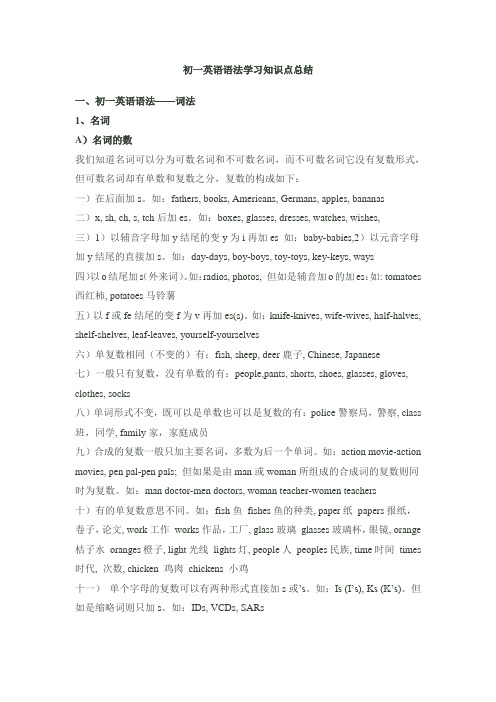
初一英语语法学习知识点总结一、初一英语语法——词法1、名词A)名词的数我们知道名词可以分为可数名词和不可数名词,而不可数名词它没有复数形式,但可数名词却有单数和复数之分,复数的构成如下:一)在后面加s。
如:fathers, books, Americans, Germans, apples, bananas二)x, sh, ch, s, tch后加es。
如:boxes, glasses, dresses, watches, wishes,三)1)以辅音字母加y结尾的变y为i再加es 如:baby-babies,2)以元音字母加y结尾的直接加s。
如:day-days, boy-boys, toy-toys, key-keys, ways四)以o结尾加s(外来词)。
如:radios, photos, 但如是辅音加o的加es:如: tomatoes 西红柿, potatoes马铃薯五)以f或fe结尾的变f为v再加es(s)。
如:knife-knives, wife-wives, half-halves, shelf-shelves, leaf-leaves, yourself-yourselves六)单复数相同(不变的)有:fish, sheep, deer鹿子, Chinese, Japanese七)一般只有复数,没有单数的有:people,pants, shorts, shoes, glasses, gloves, clothes, socks八)单词形式不变,既可以是单数也可以是复数的有:police警察局,警察, class 班,同学, family家,家庭成员九)合成的复数一般只加主要名词,多数为后一个单词。
如:action movie-action movies, pen pal-pen pals; 但如果是由man或woman所组成的合成词的复数则同时为复数。
如:man doctor-men doctors, woman teacher-women teachers十)有的单复数意思不同。
初一英语语法大全知识点
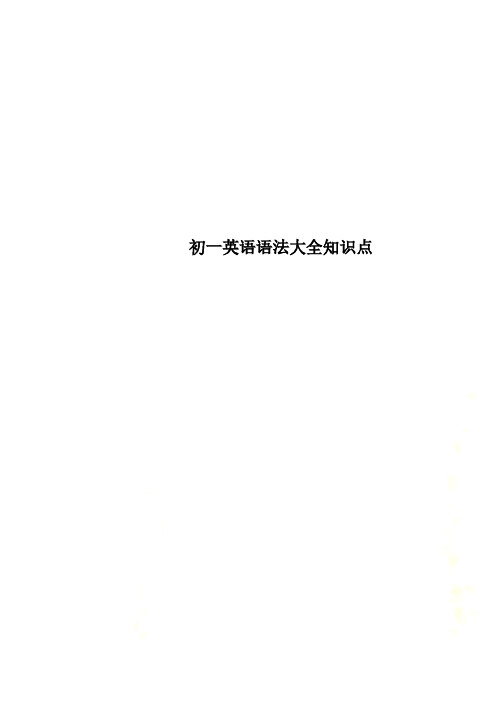
evening ! 例如:
(1) Bob: Good morning , Helen ! Helen : Good morning , Bob !
(2) Bob : Good afternoon , Helen !
Helen : Good afternoon , Bob !
(注
意句子标点)
(3) Bob : Good evening , Helen !
Unit 1 My name’s Gina
一、what is , 缩略式 what’s , 表示“是什么”。
问“某人的名字是什么”、“某人的姓是什么”、
“某人的电话号码是什么”,都用 what is 。
1、问某人的名字句型
问句: What’s your name ?
答句:
My name’s + 名字。
am--------------- I is----------------are --------------
heshe it this tha 单数名词 不可数名词 动词不定式 动名词 we you they these those 复数名词
(第一人称单数主语) (第三人称单数主语)
(复数主语)
about 关于 大
约 us 我们
her 她的
ear 耳朵
English 英语 sure 当然
可以
air 空气
or 或者
any 一些
boy 男孩
orange
橙子,桔子 map 地图
tree 树
math 数学
off 离开
watch 观看
手表 do 做
like 喜欢
beds 床
what 什么
七年级英语语法总结
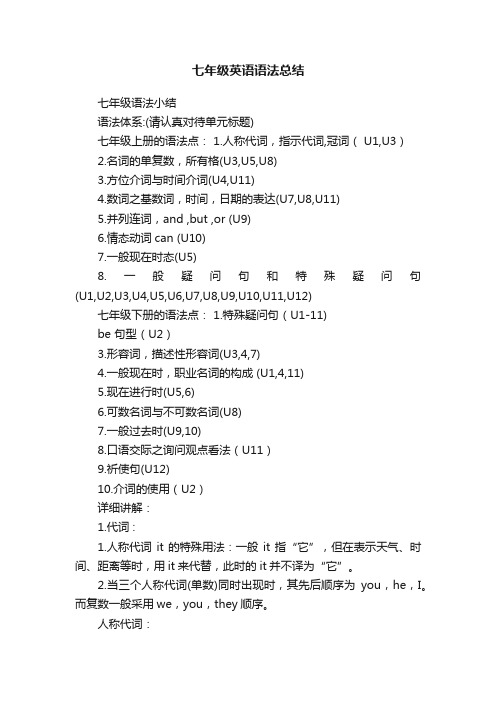
七年级英语语法总结七年级语法小结语法体系:(请认真对待单元标题)七年级上册的语法点: 1.人称代词,指示代词,冠词( U1,U3)2.名词的单复数,所有格(U3,U5,U8)3.方位介词与时间介词(U4,U11)4.数词之基数词,时间,日期的表达(U7,U8,U11)5.并列连词,and ,but ,or (U9)6.情态动词can (U10)7.一般现在时态(U5)8.一般疑问句和特殊疑问句(U1,U2,U3,U4,U5,U6,U7,U8,U9,U10,U11,U12)七年级下册的语法点: 1.特殊疑问句(U1-11)be 句型(U2)3.形容词,描述性形容词(U3,4,7)4.一般现在时,职业名词的构成 (U1,4,11)5.现在进行时(U5,6)6.可数名词与不可数名词(U8)7.一般过去时(U9,10)8.口语交际之询问观点看法(U11)9.祈使句(U12)10.介词的使用(U2)详细讲解:1.代词 :1.人称代词it的特殊用法:一般it指“它”,但在表示天气、时间、距离等时,用it来代替,此时的it并不译为“它”。
2.当三个人称代词(单数)同时出现时,其先后顺序为you,he,I。
而复数一般采用we,you,they顺序。
人称代词:物主代词:指示代词: this that ,these, those(1)为了避免重复,可用that,those代替前面提到过的名词,但是this,these不可以。
(2)this,that有时可代替句子或句子中的一部分。
句型:练习:(我) am a worker. _________(你) are a doctor. ______(她) is a teacher.is (他的 )shirt.3. This is __________(我的)pen.(他们的) trousers are there.5. I like this picture. Please give ________(它) to ________(我).6. People get ________(他们的) money from _________(我).(他们) are new students. _____(他们的) names are Lucy and Lily.8. These are _____(我们的) shoes. Can ____(我们) wear ______(它们).9.Thank _______ for _______(你的) help.10. _______(他) loves _______(她), and _______(她) loves _______(他),too._______(我) love _________(你), and ________(你) love _______(我),too.11. The weather in Beijing is much colder than ____ in Guangzhou.(指示代词)2. 冠词1.不定冠词an用在元音读音开头(不是指元音字母)的词前,其余用不定冠词a.2.定冠词(the)的基本用法A.用在重新提到的人或事物前面。
七年级英语全部知识点汇总
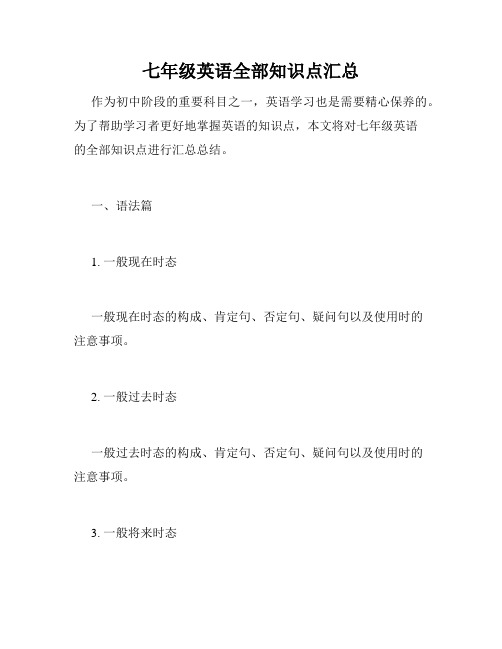
七年级英语全部知识点汇总作为初中阶段的重要科目之一,英语学习也是需要精心保养的。
为了帮助学习者更好地掌握英语的知识点,本文将对七年级英语的全部知识点进行汇总总结。
一、语法篇1. 一般现在时态一般现在时态的构成、肯定句、否定句、疑问句以及使用时的注意事项。
2. 一般过去时态一般过去时态的构成、肯定句、否定句、疑问句以及使用时的注意事项。
3. 一般将来时态一般将来时态的构成、肯定句、否定句、疑问句以及使用时的注意事项。
4. there be句型there be句型的构成、使用时的注意事项、肯定句、否定句、疑问句以及其在生活中的应用。
5. 情态动词情态动词的种类、用法、肯定句、否定句、疑问句以及在不同语境中的使用。
二、词汇篇1. 常用动词常用动词的用法、特点、时态及常见搭配。
2. 常用名词常用名词的分类、用法、大小写及常见搭配。
3. 常用形容词常用形容词的种类、修饰范围、时态及常见搭配。
4. 常用副词常用副词的种类、用法、修饰范围、时态及常见搭配。
5. 介词短语介词短语的种类、用法、修饰范围、时态及常见搭配。
三、听说读写篇1. 听力听力训练的方法、技巧以及注意事项。
2. 口语口语训练的方法、技巧、句型及常见会话场景。
3. 阅读阅读技巧、记笔记方法、阅读理解及常用阅读材料。
4. 写作写作技巧、常用句型及作文类型。
四、常用句型篇1.表达喜欢和不喜欢的常用句型表达自己的兴趣、爱好及个人喜好的常用英语句型。
2.谈论家庭的常用句型介绍自己的家庭成员、家庭状况及其他相关事宜的常用英语句型。
3.表达时间和日常安排的常用句型谈论日常安排及时间安排,以及在表达时间时常用的句型。
4.谈论旅游和活动的常用句型谈论自己喜欢的旅游目的地、旅游方式及其他活动,以及在此类话题中常用的句型。
五、常用短语篇1. 常用问候语适用于各种场合的常见问候语及相应回答。
2. 商务用语适用于商务活动中的常见用语,例如谈判、面试、签约等。
3. 用于旅游的短语适用于各种旅游场合,例如订酒店、租车、询问路线等。
初一英语知识点总结
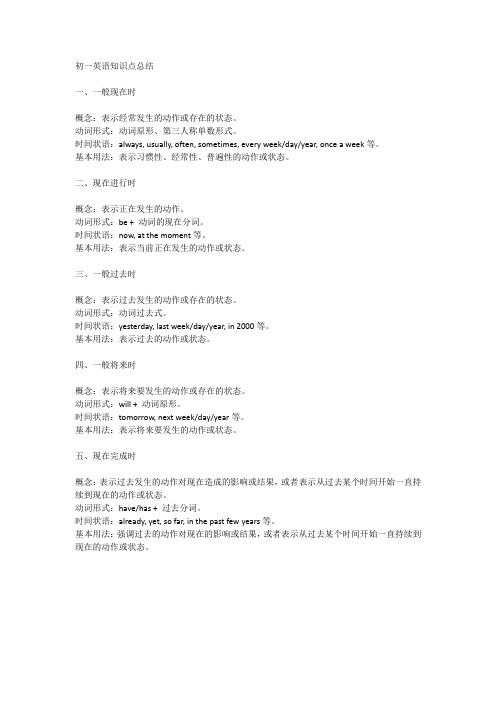
初一英语知识点总结
一、一般现在时
概念:表示经常发生的动作或存在的状态。
动词形式:动词原形、第三人称单数形式。
时间状语:always, usually, often, sometimes, every week/day/year, once a week等。
基本用法:表示习惯性、经常性、普遍性的动作或状态。
二、现在进行时
概念:表示正在发生的动作。
动词形式:be + 动词的现在分词。
时间状语:now, at the moment等。
基本用法:表示当前正在发生的动作或状态。
三、一般过去时
概念:表示过去发生的动作或存在的状态。
动词形式:动词过去式。
时间状语:yesterday, last week/day/year, in 2000等。
基本用法:表示过去的动作或状态。
四、一般将来时
概念:表示将来要发生的动作或存在的状态。
动词形式:will + 动词原形。
时间状语:tomorrow, next week/day/year等。
基本用法:表示将来要发生的动作或状态。
五、现在完成时
概念:表示过去发生的动作对现在造成的影响或结果,或者表示从过去某个时间开始一直持续到现在的动作或状态。
动词形式:have/has + 过去分词。
时间状语:already, yet, so far, in the past few years等。
基本用法:强调过去的动作对现在的影响或结果,或者表示从过去某个时间开始一直持续到现在的动作或状态。
最全七年级英语语法知识点汇总

最全七年级英语语法知识点汇总英语语法虽然是从简单的一些日常用语出发的,但语法中常会有一些知识点看起来很细小,容易被忽视,但这些知识点掌握不熟练,往往会造成一些语法应用上的错误。
接下来是为大家整理的最全(七班级英语)语法知识点汇总,希望大家喜欢!最全七班级英语语法知识点汇总一1.陈述句肯定陈述句a)Thisisabook.(be动词)b)Helooksveryyoung.(连系动词)c)Iwantasweatlikethis.(实义动词)d)Icanbringsomethingstoschool.(情态动词)e)There’sacomputeronmydesk.(Therebe结构)否定陈述句a)Thesearen’ttheirbooks.b)Theydon’tlooknice.c)Katedoesn’tgotoNo.4MiddleSchool.d)Katecan’tfindherdoll.e)Thereisn’tacathere.(=There’snocathere.)2.祈使句肯定祈使句a)Pleasegoandasktheman.b)Let’slearnEnglish!c)Comein,please.否定祈使句a)Don’tbelate.b)Don’thurry.3.疑问句1)一般疑问句a)IsJimastudent?b)CanIhelpyou?c)Doesshelikesalad?d)DotheywatchTV?e)Isshereading?肯定回答:a)Yes,heis.b)Yes,youcan.c)Yes,shedoes.d)Yes,theydo.e)Yes,sheis.否定回答:a)No,heisn’t.b)No,youcan’t.c)No,shedoesn’t.d)No,theydon’t.e)No,shei sn’t.2)选择疑问句Isthetablebigorsmall?回答It’sbig./It’ssmall.3)特殊疑问句①问年龄HowoldisLucy?Sheistwelve.②问种类Whatkindofmoviesdoyoulike?Ilikeactionmoviesandcomedies.③问身体状况Howisyouruncle?Heiswell/fine.④问方式Howdo/canyouspellit?L-doubleO-K.Howdowecontactyou?Mye-*******************************.⑤问原因Whydoyouwanttojointheclub?⑥问时间What’sthetime?(=Whattimeisit?)It’saquartertotena.m..Whattimedoyouusuallygetup,Rick?Atfiveo’clock.Whendoyouwanttogo?Let’sgoat7:00.⑦问地方Where’smybackpack?It’sunderthetable.⑧问颜色Whatcolorarethey?Theyarelightblue.What’syourfavouritecolor?It’sblack.⑨问人物Who’sthat?It’smysister.Whoistheboyinblue?Mybrother.Whoisn’tatschool?PeterandEmma.WhoareLisaandTimtalkingto?⑩问东西What’sthis/that(inEnglish)?It’sapencilcase.Whatelsecanyouseeinthepicture?Icanseesomebroccoli,strawberriesandh amburgers.11问姓名What’syouraunt’sname?HernameisHelen./She’sHelen.What’syourfirstname?Myfirstname’sBen.What’syourfamilyname?Myfamilyname’sSmith.12问哪一个Whichdoyoulike?Ilikeoneinthebox.13问字母Whatletterisit?It’sbigD/smallf.14问价格Howmucharethesepants?They’re15dollars.15问电话号码What’syourphonenumber?It’s576-8349.16问谓语(动作)What’shedoing?He’swatchingTV.17问职业(身份)Whatdoyoudo?I’mateacher.What’syourfather?He’sadoctor.最全七班级英语语法知识点汇总二首先要介绍的就是关于动词be(is,am,are)的用法,动词在一个(句子)中很重要,对于英语来说be(is,am,are)更是常常用到,学会be 的用法就是学好英语的根基。
七年级英语语法知识点总结
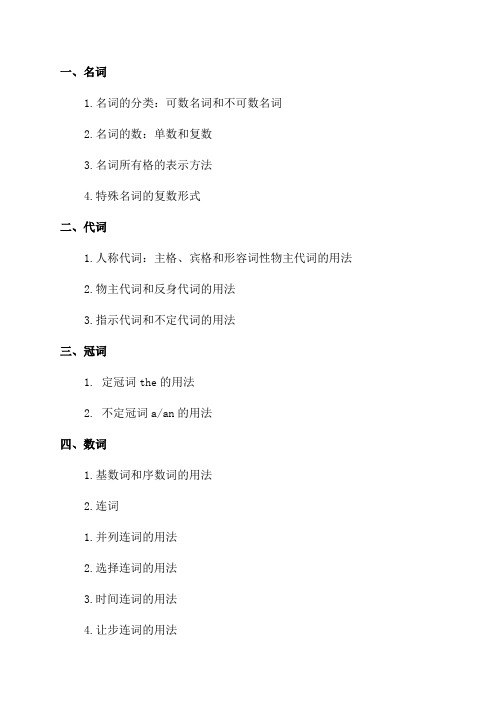
一、名词1.名词的分类:可数名词和不可数名词2.名词的数:单数和复数3.名词所有格的表示方法4.特殊名词的复数形式二、代词1.人称代词:主格、宾格和形容词性物主代词的用法2.物主代词和反身代词的用法3.指示代词和不定代词的用法三、冠词1. 定冠词the的用法2. 不定冠词a/an的用法四、数词1.基数词和序数词的用法2.连词1.并列连词的用法2.选择连词的用法3.时间连词的用法4.让步连词的用法5.结果连词的用法五、形容词和副词1.形容词的用法和比较级、最高级的构成2.副词的用法和比较级、最高级的构成六、时间状语从句1.引导时间状语从句的连词的用法2.时间状语从句的时态和语序七、地点状语从句1.引导地点状语从句的连词的用法八、因果状语从句1.引导因果状语从句的连词的用法九、条件状语从句1.引导条件状语从句的连词的用法2.条件状语从句的时态和语序十、目的状语从句1.引导目的状语从句的连词的用法十一、同位语从句1.同位语从句的引导词十二、定语从句1.引导定语从句的关系代词和关系副词的用法十三、省略句1.句子中的省略现象十四、被动语态1.被动语态的构成和用法十五、宾语从句1.引导宾语从句的连词的用法十六、反意疑问句1.反意疑问句的构成和用法十七、动词时态和语态1.一般现在时、一般过去时和一般将来时的构成和用法2.现在进行时和过去进行时的构成和用法3.现在完成时和过去完成时的构成和用法4.一般将来时和一般过去将来时的构成和用法。
(完整版)初一英语语法知识点总结复习(超详细)
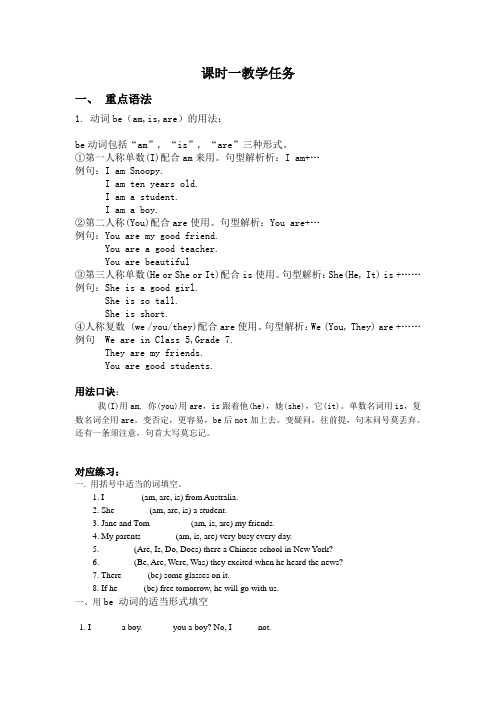
课时一教学任务一、重点语法1.动词be(am,is,are)的用法:be动词包括“am”, “is”, “are”三种形式。
①第一人称单数(I)配合am来用。
句型解析析:I am+…例句:I am Snoopy.I am ten years old.I am a student.I am a boy.②第二人称(You)配合are使用。
句型解析:You are+…例句:You are my good friend.You are a good teacher.You are beautiful③第三人称单数(He or She or It)配合is使用。
句型解析:She(He, It) is +……例句:She is a good girl.She is so tall.She is short.④人称复数 (we /you/they)配合are使用。
句型解析:We (You, They) are +……例句 We are in Class 5,Grade 7.They are my friends.You are good students.用法口诀:我(I)用am, 你(you)用are,is跟着他(he),她(she),它(it)。
单数名词用is,复数名词全用are。
变否定,更容易,be后not加上去。
变疑问,往前提,句末问号莫丢弃。
还有一条须注意,句首大写莫忘记。
对应练习:一. 用括号中适当的词填空。
1. I ________(am, are, is) from Australia.2. She _______ (am, are, is) a student.3. Jane and Tom _________(am, is, are) my friends.4. My parents _______ (am, is, are) very busy every day.5. _______ (Are, Is, Do, Does) there a Chinese school in New York?6. _______ (Be, Are, Were, Was) they excited when he heard the news?7. There _____ (be) some glasses on it.8. If he _____ (be) free tomorrow, he will go with us.一、用be 动词的适当形式填空1. I ______ a boy. ______ you a boy? No, I _____ not.2. The girl______ Jack's sister.3. The dog _______ tall and fat.4. The man with big eyes _______ a teacher.5. ______ your brother in the classroom?6. Where _____ your mother? She ______ at home.7. How _______ your father?8. Mike and Liu Tao ______ at school.9. Whose dress ______ this?10. Whose socks ______ they?11. That ______ my red skirt.12. Who ______ I?13.The jeans ______ on the desk.14.Here ______ a scarf for you.15. Here ______ some sweaters for you.16. The black gloves ______ for Su Yang.17. This pair of gloves ______ for Yang Ling.18. The two cups of milk _____ for me.19. Some tea ______ in the glass.20. Gao shan's shirt _______ over there.第二课时(1)英语人称代词和物主代词一、人称代词表示“我”、“你”、“他”、“她”、“它”、“我们”、“你们”、“他们”的词,叫做人称代词。
初一英语语法大全知识点

第一块国际音标国际音标是一种工具,其作用是标记英语字母和单词的读音。
1、20个元音单元音:/i:/ Ee、/з:/her /u:/ do/I/ it /ә/about /u/ book/ɑ:/ are // or /æ/ any// us // off /e/ at双元音:// Ii // out // ear// Aa,// Oo // air// boy // sure2、28辅音:成对的清浊辅音:/p/map /t/ it /k/book /f/off /θ/math /s/yes /b/club /d/dad /g/big /v/have /ð/this /z/zoo// fish // watch /tr/ tree /ts/ its// usually // orange /dr/ dress /dz/ beds其他辅音:/m/ am /n/ and // English /l/ like/h/ hello /r/ red /w/ what /j/ yes3、国际音标拼读规则:辅见元,碰一碰。
/l/在前,发本音;音节后面卷下舌。
/p/、/t/、/k/、/tr /清辅音,/s/后读成浊辅音。
本块词汇:speak说讲start开始school学校 s trict严格的out外面club俱乐部usually通常 dress化妆about关于大约us我们her她的ear耳朵English英语sure当然可以air空气or或者any一些boy男孩orange橙子,桔子map地图tree树math数学 off离开watch观看手表do做like喜欢 beds床what什么hello喂是的red红色的yes是的 book书its它的 zoo动物园fish鱼dad爸爸big大的have有this这it它Starter unit1-3一、文化常识1、英语文化区域,熟人之间见面,常要互相问好。
初一英语语法及主要知识点归纳总结

初一英语知识点归纳总结分类:英语学习Unit 1 Where’s your pen pal from一.短语:1 .be from = come from 来自于----2.live in 居住在---3.on weekends 在周末4 .write to sb = write a letter to sb 给某人写信;写信给某人5 .in the world 在世界上in China 在中国6.pen pal 笔友14 years old 14岁favorite subject 最喜欢的科目7.the United States 美国the United Kingdom 英国New York 纽约8.speak English 讲英语like and dislike 爱憎9.go to the movies 去看电影play sports 做运动二.重点句式:1 Where’s your pen pal from = Where does your pen pal from/2 Where does he live3 What languages does he speak4 I want a pen pal in China.5 I can speak English and a little French.6 Please write and tell me about yourself.7 Can you write to me soon8 I like going to the movies with my friends and playing sports.三.本单元的国家,人民、语言对应;1 Canada---- Canadian---- English / French2 France------ French------French3 Japan------Japanese----Japanese4 Australia----Australian----- English5 the United States------ American---- English6 the United Kingdom---British----- EnghishU nit 2 Where’s the post office一.Asking ways: 问路1.Where is the nearest …… 最近的……在哪里2.Can you tell me the way to …… 你能告诉我去……的路吗3.How can I get to …… 我怎样到达……呢4.Is there …… near here / in the neighborhood 附近有……吗5.Which is the way to ……哪条是去……的路二.Showing the ways: 指路1. Go straight down / along this street. 沿着这条街一直走;2. Turn left at the second turning. 在第二个路口向左转;3. You will find it on your right. 你会在你右手边发现它;4. It is about one hundred metres from here. 离这里大约一百米远;5. You’d bette r take a bus. 你最好坐公交车去;You’d better+动词原形三.词组1. across from …… 在……的对面across from the bank 在银行的对面2. next to…… 紧靠…… next to the supermarket 紧靠超市3. between……and…… 在……和……之间between the park and the zoo 在公园和动物园之间among 表示位于三者或三者以上之间4. in front of…… 在……前面There is a tree in front of the classroom.课室前面有棵树;in the front of…… 在……内的前部There is a desk in the front of the classroom.课室内的前部有张桌子;5. behind…… 在……后面behind my house 在我家后面6. turn left/ right 向左/右拐on the left/right of…… 在某物的左/右边on the left of our school 在我们学校的左边on one’s left/right 在某人的左/右边on my left 在我左边7. go straight 一直走8. down /along…… 沿着……街道down/along Center Street 沿着中央街9. in the neighborhood=near here 在附近10 welcome to…… 欢迎来到……11. take /have a walk 散步12. the beginning o f…… ……的开始,前端at the beginning of…… 在……的开始,前端in the beginning 起初,一开始13. have fun=have a good time=enjoy oneself 玩得开心,过得愉快我昨天玩得很开心; I had fun yesterday.I had a good time yesterday.I enjoyed myself yesterday.14. have a good trip 旅途愉快15. take a taxi 坐出租车16. 到达:get to +地方get here/ there/ home 到这/那/家arrive in +大地方I arrive in Beijing.arrive at +小地方I arrive at the bank.reach +地方17.go across 从物体表面横过go across the street 横过马路go through 从空间穿过go through the forest 穿过树林18.on + 街道的名称; Eg: on Center Streetat + 具体门牌号+街道的名称Eg: at 6 Center Street三.重难点解析1.enjoy doing sth 享受做某事的乐趣,喜爱做某事I enjoy reading. 我喜爱读书;到目前为止,我们学了两个特殊的动词finish和enjoy,都是要带doing.I finish cleaning the room. 我扫完了这间屋子;2.hope to do sth 希望做某事I hope to pass this exam. 我希望通过这次考试; hope +从句I hope tomorrow will be fine. 我希望明天将会晴朗;从句即是一个小句子,这个小句子又放在大句子中,从属于大句子,所以叫从句;如tomorrow will be fine是一个从句,它又放在I hope 的后面,形成句中有句;3. if 引导一个表示假设的句子;If I have much money, I will go to the moon. 如果我有许多钱,我就会去月球;If you are hungry, you can buy some food in the supermarket.如果你饿了的话,你可以在超市买一些食物;四.本单元的反义词、近义词配对1new—old 2 quiet--- busy 3 dirty--- clean 4 big---- smallUnit 3 Why do you like koala bears一.重点词组eat grass eat leaves be quiet very shy very smart very cuteplay with her friends kind of South Africa other animalsat night in the day every day during the day二. 交际用语1. Why do you like pandas Because they’re very clever.2. Why does he like koalas Because they’re kind of interesting.3. Where are lions from They are from South Africa.4. What other animals do you likeI like dogs, too.WhyBecause they’re friendly and clever.5. Molly likes to play with her friends and eat grass.6. She’s very shy.7. He is from Australia.8.He sleeps during the day, but at night he gets up and eats leaves.9.He usually sleeps and relaxes 20 hours every day.10.Let’s see the pandas first.11.They’re kind of interesting.12.What other animals do you like13.Why do you want to see the lions三. 重点难点释义1、kind of 有点,稍微Koala bears are kind of shy. 考拉有点害羞;kind 还有“种类”的意思如:各种各样的all kinds ofWe have all kinds of beautiful flowers in our school.2、China n. 中国Africa n. 非洲China 和Africa都是专有名词,首字母都应该大写,而且和介词in连用;There are many kinds of tigers in China.There are many kinds of scary animals in Africa.3、friendly adj. 友好的,和蔼可亲的它是名词friend的形容词形式,常常和be动词连用, be friendly;The people in Chengdu are very friendly.4、with prep. 跟,同,和…在一起I usually play chess with my father.注意区别与and的用法,and通常用于连接主语或宾语,连接主语时,如果有I, I通常放在and 之后,如:My father and I usually play chess together.Play with “和…一起玩耍”“玩…”I often play with my pet dog.Don’t play with water5、day和night 是一对反义词,day 表示白天或一天,night表示夜或夜晚;通常说in the day, during the day, at night;Koala bears often sleep during the day and eat leaves at night.6、leaf n. 叶子复数形式为:leaves, 类似的变化还有:wife—wives, wolf—wolves, knife—knives等;7、hour n. 小时;点钟hour前边通常加上冠词an 表示“一个小时”, 即:an hour;There are 24 hours in a day and 60minutes in an hour.8、be from 来自…be from = come fromPandas are from China. = Pandas come form China.9、meat n. 食用的肉,为不可数名词,表示“许多”时,使用much来修饰,即:much meatHe eats much meat every day.10、grass n. 草,为不可数名词,表示“许多”时,使用much来修饰,即:much grass; There is much grass on the playground.四. 语法知识特殊疑问句通常以“what”、“who”、“which”、“when”、“where”、“how”、“how old”、“how many”等开头,对某一具体问题进行提问;特殊疑问句的基本构成有两种情况:1. 疑问句+一般疑问句结构;这是最常见的情况;例如:What’s your grandfather’s telephone number 你爷爷的号码是多少Who is that boy with big eyes 那个大眼睛的男孩是谁Which season do you like best 你最喜欢哪个季节When is he going to play the piano 他什么时候弹钢琴Where does he live 他住在哪儿How are you 你好吗How old are you 你多大了How many brothers and sisters do you have 你有几个兄弟姐妹2. 疑问句+陈述句结构;这时疑问词作主语或修饰主语;例如:Who is on duty today今天谁值日Which man is your teacher哪位男士是你的老师我们学过的What/How about+名词/代词+其他也是特殊疑问句,它是一种省略结构;例如:I like English. What/How about you 我喜欢英语;你呢What about playing basketball 打篮球怎么样Unit 4 I want to be an actor.一.短语:1 want to do sth 想要作某事2 give sb sth = give sth to sb 给某人某物/ 把某物给某人3 help sb do sth 帮助某人作某事Eg: I want to help my mother do some housework at home.4 help sb with sth 帮助某人谋事Eg: I want to help my mother with some housework at home5 in the day 在白天6 at night 在晚上7 talk with/ to sb 和----谈话8 be busy doing sth 忙于做某事Eg: He is busy listening to the teacher.9 in a hospital 在医院l10 work/ study hard 努力工作11 Evening Newspaper 晚报二.重点句式及注意事项:1 询问职业的特殊疑问词是what;有三种主要句式①What + is / are + sb②What + does/ do + sb + do③What + is/ are + 名词所有格/ 形容词性物主代词+ job2 People give me their money or get their money from me.3 Sometimes I work in the day and sometimes at night.4 I like talking to people.5 I work late. I’m very busy when people go out to dinners.6 Where does your sister work7 then we have a job for you as a waiter.8 Do you want to work for a magazine Then come and work for us as a reporter.9 Do you like to work evenings and weekends10 We are an international school for children of 5-12.三.本单元中的名词复数;1 policeman--- policemen2 woman doctor----- women doctors 3thief-----thieves首先主谓宾结构I have an apple.其次定状补I really have a big apple.really做have的状语状语修饰动词动词一般就是谓语动词big做apple的定语定语修饰名词名词一般是主语或宾语最后主系表结构它与主谓宾很相似只不过谓语动词时系动词最常见的是be动词及其变形I am a student;主语通常用于句子开端,主要有:i,you,he,she,it,we,they,但it有时用作形式主语,表特指;谓语,通常放在主语之后,一般是动词,表示“某某人在;;;”宾语,通常放在谓语之后,一般是主语的宾格;有时候是人,有时候是物;定语,状语,通常是从句;定语从句:常有关系代词that\which\who\whoes,关系副词when\where\why.通常选择关系词的步骤是:1、确定先行词2.确定关系词.主系表:主,就是主语;系,特指系动词,就是说当句子中没有谓语时,用系动词来代替;表,修饰系动词用;1、名词A、名词的数我们知道名词可以分为可数名词和不可数名词,而不可数名词它没有复数形式,但可数名词却有单数和复数之分,复数的构成如下:一在后面加s;如:fathers, books, Americans, Germans, apples, bananas二x, sh, ch, s, tch后加es;如:boxes, glasses, dresses, watches, wishes, faxes三1以辅音字母加y结尾的变y为i再加es 如:baby-babies, family-families, duty-duties, comedy-comedies, documentary-documentaries, story-stories2以元音字母加y结尾的直接加s;如:day-days, boy-boys, toy-toys, key-keys, ways四以o结尾加s外来词;如:radios, photos, 但如是辅音加o的加es:如: tomatoes 西红柿, potatoes马铃薯五以f或fe结尾的变f为v再加ess;如:knife-knives, wife-wives, half-halves, shelf-shelves, leaf-leaves, yourself-yourselves六单复数相同不变的有:fish, sheep, deer鹿子, Chinese, Japanese七一般只有复数,没有单数的有:people,pants, shorts, shoes, glasses, gloves, clothes, socks八单词形式不变,既可以是单数也可以是复数的有:police警察局,警察, class班,同学, family家,家庭成员九合成的复数一般只加主要名词,多数为后一个单词;如:action movie-action movies, pen pal-pen pals; 但如果是由man或woman所组成的合成词的复数则同时为复数;如:man doctor-men doctors, woman teacher-women teachers十有的单复数意思不同;如:fish鱼fishes鱼的种类, paper纸papers报纸,卷子,论文, work工作works作品,工厂, glass玻璃glasses玻璃杯,眼镜, orange桔子水oranges橙子, light光线lights灯, people人peoples民族, time时间times 时代, 次数, chicken 鸡肉chickens 小鸡十一单个字母的复数可以有两种形式直接加s或’s;如:Is I’s, Ks K’s;但如是缩略词则只加s;如:IDs, VCDs, SARs十二特殊形式的有:child-children, man-men, woman-women, foot-feet, mouse-mice, policeman-policemen, Englishman-EnglishmenB名词的格当我们要表示某人的什么东西或人时,我们就要使用所有格形式;构成如下:一单数在后面加’s;如:brother’s, Mike’s, teacher’s二复数以s结尾的直接在s后加’,如果不是以s结尾的与单数一样处理;如:Teachers’ Day教师节, classmates’; Children’s Day六一节, Women’s Day三八节三由and并列的名词所有时,如果是共同所有同一人或物时,只加最后一个’s,但分别拥有时却分别按单数形式处理;如:Mike and Ben’s room迈克和本的房间共住一间,Mike’s and Ben’s rooms迈克和本的房间各自的房间2、代词项目人称代词物主代词指示代词反身代词人称主格宾格形容词名词性第一人称单数I me my mine myself复数we us our ours ourselves第二人称单数you you your yours yourself复数you you your yours yourselves第三人称单数she her her hers herselfhe him his his himselfit it its its this that itself复数they them their theirs these those themselves3、动词A 第三人称单数当动词是第三人称单数时,动词应该像名词的单数变动词那样加s,如下:一一般在词后加s;如:comes, spells, waits, talks, sees, dances, trains二在x, sh, ch, s, tch后加es;如:watches, washes, wishes, finishes三1以辅音字母加y结尾的变y为i再加es;如:study-studies, hurry-hurries, try-tries2以元音字母加y结尾的直接加s;如:plays, says, stays, enjoys, buys四以o结尾加es;如:does, goes五特殊的有:are-is, have-hasB 现在分词当我们说某人正在做什么事时,动词要使用分词形式,不能用原形,构成如下:一一般在后加ing;如:spell-spelling, sing-singing, see-seeing, train-training, play-playing, hurry-hurrying, watch-watching, go-going, do-doing二以不发音e的结尾的去掉e再加ing;如:dance-dancing, wake-waking,take-taking, practice-practicing, write-writing, have-having三以重读闭音节结尾且一个元音字母+一个辅音字母注意除开字母组合如show –showing, draw-drawing要双写最后的辅音字母再加ing;如:put-putting,run-running, get-getting, let-letting, begin-beginning四以ie结尾的变ie为y再加ing;如:tie-tying系die-dying死lie-lying 位于4、形容词的级我们在对两个或以上的人或物进行对比时,则要使用比较或最高级形式;构成如下:一一般在词后加er或est如果是以e结尾则直接加r或st;如:greater-greatest, shorter –shortest, taller –tallest, longer –longest, nicer- nicest, larger -largest二以重读闭音节结尾且1个元音字母+1个辅音字母字母组合除外,如few-fewer fewest结尾的双写结尾的辅音再加er /est;如:big-bigger biggest, red-redder reddest, hot-hotter hottest三以辅音字母+y结尾的变y为i加er/est;如:happy-happier happiest,sorry-sorrier sorriest, friendly-friendlier friendliestmore friendly most friendly, busy-busier busiest, easy-easier easiest四特殊情况:两好多坏,一少老远good/well - better best many/much - more most bad/ill – worse worstlittle- less least old- older/elder oldest/eldest far- farther/further farthest/furthest 5、数词基变序,有规则;一、二、三,自己背;五、八、九、十二;其它后接th;y结尾,变为i, eth跟上去; first, second, third; fifth, eighth, ninth, twelfth; seventh, tenth, thirteenth, hundredth; twenty-twentieth, forty-fortieth, ninety-ninetieth二、初一英语语法——句式1.陈述句肯定陈述句a This is a book. be动词b He looks very young. 连系动词c I want a sweat like this. 实义动词d I can bring some things to school. 情态动词e There’s a computer on my desk. There be结构否定陈述句a These aren’t their books. b They don’t look nice.c Kate doesn’t go to No. 4 Middle School.d Kate can’t find her doll.e There isn’t a cat here. =There’s no cat here.2. 祈使句肯定祈使句a Please go and ask the man. b Let’s learn Englishc Come in, please.否定祈使句a Don’t be late. b Don’t hu rry.3. 疑问句1 一般疑问句a Is Jim a student b Can I help you c Does she like saladd Do they watch TVe Is she reading肯定回答: a Yes, he is. b Yes, you can. c Yes, she does. d Yes, they do. e Yes, she is.否定回答: a No, he isn’t. b No, you can’t. c No, she doesn’t. d No, they don’t. e No, she isn’t.2 选择疑问句Is the table big or small 回答It’s big./ It’s small.3 特殊疑问句①问年龄How old is Lucy She is twelve.②问种类What kind of movies do you like I like action movies and comedies.③问身体状况How is your uncle He is well/fine.④问方式How do/can you spell it L-double O-K.How do we contact you My e-mail address is cindyjones163.⑤问原因Why do you want to join the club⑥问时间What’s the time =What time is it It’s a quarter to ten a.m..What time do you us ually get up, Rick At five o’clock.When do you want to go Let’s go at 7:00.⑦问地方Where’s my backpack It’s under the table.⑧问颜色What color are they They are light blue.What’s your favourite color It’s black.⑨问人物Who’s that It’s my sister.Who is the boy in blue My brother.Who isn’t at school Peter and Emma.Who are Lisa and Tim talking to⑩问东西What’s this/that in English It’s a pencil case.What else can you see in the picture I can see some broccoli, strawberries and hamburgers.11问姓名What’s your aunt’s name Her name is Helen./She’s Helen. What’s your first name My first name’s Ben.What’s your family name My family name’s Smith.12 问哪一个Which do you like I like one in the box.13 问字母What letter is it It’s big D/small f.14 问价格How much are these pants They’re 15 dollars.15 问号码What’s your phone number It’s 576-8349.16 问谓语动作What’s he doing He’s watching TV.17 问职业身份 What do you do What’s your father He’s a doctor.句子结构1.S主+ Vi不及物动词谓Time flies.1 S + V + adverbial状语Birds sing beautifully.2 S + Vi+ prep Phrase介词短语He went on holiday.3 S + Vi+ Infinitive 不定式We stopped to have a rest.4 S + Vi+ Participle 分词I'll go swimming.2. S 主+ Vt 及物动词谓+ O宾We like English.1 S + VT + N/PronI like music.I like her.2 S + VT + infinitive不定式I want to help him.常用于这句型的动词有:attempt, dare, decide, desire, expect, hope, intend, learn, need, offer, pretend, promise, propose, purpose, refuse, want, wish等;3 S + VT + Wh-Word + InfinitiveI don't know what to do.常用于这句型的动词有:ask, consider, decide, discover, explain, find out, forget, guess, inquire, know, learn, observe, remember, see, settle, tell, think, understand, wonder等;4 S + VT + GerundI enjoy living here.常用于这句型的动词有:admit, advise, avoid, consider, defend, enjoy, excuse, finish, forbid, mind, miss, practise, risk, suggest, give up, can't help等;5 S + VT + That-clauseI don't think that he is right.常用于这句型的动词有:Admit, believe, command, confess, declare, demand, deny, doubt, expect, explain, feel觉得, hear听说, hope, imagine, intend, know, mean, mind当心, notice, propose, request, report, say, see看出,show, suggest, suppose, think, understand, wish, wonder觉得奇怪;3. S 主+ V谓lv 系动词+ P表We are Chinese.除了be 系动词外,还有一些动词也可以用作系动词,1表感官的动词,feel, smell, taste, sound, look, appear, seem 等;2 表转变变化的动词,become, get, grow, turn, go,等; 3表延续的动词remain, keep, seem, hold, stay, rest等;4表瞬时的动词come, fall, set, cut, occur等5其他动词eat, lie, prove, ring, run, shine, sit, stand, continue, hang等;1 S + Lv + N/Pron名词/代词He is a boy.This is mine.2 S + Lv + Adj形容词She is beautiful.3 S + Lv + Adv 副词Class is over.4 S + Lv + Prep PhraseHe is in good health.5 S + Lv + Participle分词He is excited.The film is interesting.4. S 主+ VT 谓+ In O间接宾+ D O直接宾I give you help.1 S + VT + N/Pron + NI sent him a book.I bought May a book.2 S + VT + N/Pron + To/for-phraseHe sent a book to me.He bought a coat for me.间接宾语前需要加to 的常用动词有:allow, bring, deny, do带来, give, grant, hand, leave, lend, offer, owe, pass, pay, permit, promise, read, refuse, render, restore, sell, send, show, teach, tell wish, write等;间接宾语前需要加for 的常用动词有:bring, buy, cash, choose, fetch, get, leave, make, order, paint, play演奏,save, sing, spare等;5. S 主+ VT谓+ O宾+ O C宾补I make you clear.1 S + VT + N/Pron + NWe named our baby Tom.常用于这句型的动词有:appoint, call, choose, elect, entitle, find, make, name, nominate命名;2 S + VT + N/Pron + AdjHe painted the wall white.常用于这句型的动词有:beat, boil, cut, drive, find, get, hold, keep, leave, like, make, paint, see, set, turn, want, wash, wipe, wish等;3 S + VT + N/Pron + Prep PhraseShe always keeps everything in good order.4 S + VT + N/Pron + InfinitiveI wish you to stay.I made him work常用于这句型的动词有:a不定式带to的词:advice, allow, ask, beg, cause, choose, command, decide, encourage, expect, force, get, hate, invite, know, leave, like, love, order, permit, persuade, prefer, remain, request, teach, tell, want, warn, wish等;b不定式不带to的词:feel, have, hear, know, let, listen to, look at, make, notice, see, watch等;5 S + VT + N/Pron + Participle 分词I heard my name called.I feel something moving.常用于这句型的动词有:catch, feel, find, get, have, hear, imagine, keep, leave, listen to, look at, notice, observe, perceive, see, set, smell, start, watch等;6 S + VT + N/Pron + Wh-word + InfinitiveHe show me how to do it.常用于这句型的动词有:advise, ask, inform, show, teach, tell等;7 S + VT + N/Pron + That-clauseHe told me that the film was great.常用于这句型的动词有:assure, inform, promise, remind, teach, tell, warm等;8 S + VT + N/Pron + Wh-ClauseHe asked me what he should do.常用于这句型的动词有:Advise, ask, inform, show, teach, tell.三、初一英语语法——时态1、一般现在时表示普遍、经常性的或长期性的动作时使用一般现在时,它有:Be 动词:She’s a worker. Is she a worker She isn’t a worker.情态动词:I can play the piano. Can you play the piano I ca n’t play the piano.行为动词:They want to eat some tomatoes. Do they want to eat any tomatoes They don’t want to eat any tomatoes.Gina has a nice watch. Does Gina have a nice watch Gina doesn’t have a watch.2、现在进行时表示动词在此时正在发生或进行就使用进行时态,结构为sb be v-ing sth + 其它.I’m playing baseball. Are you playing baseball I’m not playing baseball. Nancy is writing a letter. Is Nancy writing a letter Nancy isn’t writing a letter.They’re listening to the pop music. Are they listening the pop music They aren’t list ening to the pop music.一.短语:1 .be from = come from 来自于----2.live in 居住在---3.on weekends 在周末4 .write to sb = write a letter to sb 给某人写信;写信给某人5 .in the world 在世界上in China 在中国6.pen pal 笔友14 years old 14岁favorite subject 最喜欢的科目7.the United States 美国the United Kingdom 英国New York 纽约8.speak English 讲英语like and dislike 爱憎9.go to the movies 去看电影play sports 做运动二.重点句式:1 Where’s your pen pal from = Where does your pen pal from/2 Where does he live3 What languages does he speak4 I want a pen pal in China.5 I can speak English and a little French.6 Please write and tell me about yourself.7 Can you write to me soon8 I like going to the movies with my friends and playing sports.三.本单元的国家,人民、语言对应;1 Canada---- Canadian---- English / French2 France------ French------French3 Japan------Japanese----Japanese4 Australia----Australian----- English5 the United States------ American---- English6 the United Kingdom---British----- EnghishUnit 2 Where’s the post office一.Asking ways: 问路1.Where is the nearest …… 最近的……在哪里2.Can you tell me the way to …… 你能告诉我去……的路吗3.How can I get to …… 我怎样到达……呢4.Is there …… near here / in the neighborhood 附近有……吗5.Which is the way to …… 哪条是去……的路二.Showing the ways: 指路1. Go straight down / along this street. 沿着这条街一直走;2. Turn left at the second turning. 在第二个路口向左转;3. You will find it on your right. 你会在你右手边发现它;4. It is about one hundred metres from here. 离这里大约一百米远;5. You’d better take a bus. 你最好坐公交车去;You’d better+动词原形三.词组1. across from …… 在……的对面across from the bank 在银行的对面2. next to…… 紧靠…… next to the supermarket 紧靠超市3. between……and…… 在……和……之间between the park and the zoo 在公园和动物园之间among 表示位于三者或三者以上之间4. in front of…… 在……前面There is a tree in front of the classroom.课室前面有棵树;in the front of…… 在……内的前部There is a desk in the front of the classroom.课室内的前部有张桌子;5. behind…… 在……后面behind my house 在我家后面6. turn left/ right 向左/右拐on the left/right of…… 在某物的左/右边on the left of our school 在我们学校的左边on one’s left/right 在某人的左/右边on my left 在我左边7. go straight 一直走8. down /along…… 沿着……街道down/along Center Street 沿着中央街9. in the neighborhood=near here 在附近10 welcome to…… 欢迎来到……11. take /have a walk 散步12. the beginning of…… ……的开始,前端at the beginning of…… 在……的开始,前端in the beginning 起初,一开始13. have fun=have a good time=enjoy oneself 玩得开心,过得愉快我昨天玩得很开心; I had fun yesterday.I had a good time yesterday.I enjoyed myself yesterday.14. have a good trip 旅途愉快15. take a taxi 坐出租车16. 到达:get to +地方get here/ there/ home 到这/那/家arrive in +大地方I arrive in Beijing.arrive at +小地方I arrive at the bank.reach +地方17.go across 从物体表面横过go across the street 横过马路go through 从空间穿过go through the forest 穿过树林18.on + 街道的名称; Eg: on Center Streetat + 具体门牌号+街道的名称Eg: at 6 Center Street三.重难点解析1.enjoy doing sth 享受做某事的乐趣,喜爱做某事I enjoy reading. 我喜爱读书;到目前为止,我们学了两个特殊的动词finish和enjoy,都是要带doing.I finish cleaning the room. 我扫完了这间屋子;2.hope to do sth 希望做某事I hope to pass this exam. 我希望通过这次考试; hope +从句I hope tomorrow will be fine. 我希望明天将会晴朗;从句即是一个小句子,这个小句子又放在大句子中,从属于大句子,所以叫从句;如tomorrow will be fine是一个从句,它又放在I hope 的后面,形成句中有句;3. if 引导一个表示假设的句子;If I have much money, I will go to the moon. 如果我有许多钱,我就会去月球; If you are hungry, you can buy some food in the supermarket.如果你饿了的话,你可以在超市买一些食物;四.本单元的反义词、近义词配对1new—old 2 quiet--- busy 3 dirty--- clean 4 big---- smallUnit 3 Why do you like koala bears一.重点词组eat grass eat leaves be quiet very shy very smart very cuteplay with her friends kind of South Africa other animalsat night in the day every day during the day二. 交际用语1. Why do you like pan das Because they’re very clever.2. Why does he like koalas Because they’re kind of interesting.3. Where are lions from They are from South Africa.4. What other animals do you likeI like dogs, too.WhyBecause they’re friendly and clever.5. Molly likes to play with her friends and eat grass.6. She’s very shy.7. He is from Australia.8.He sleeps during the day, but at night he gets up and eats leaves. 9.He usually sleeps and relaxes 20 hours every day.10.Let’s see the pandas first.11.They’re kin d of interesting.12.What other animals do you like13.Why do you want to see the lions三. 重点难点释义1、kind of 有点,稍微Koala bears are kind of shy. 考拉有点害羞;kind 还有“种类”的意思如:各种各样的all kinds ofWe have all kinds of beautiful flowers in our school.2、China n. 中国Africa n. 非洲China 和Africa都是专有名词,首字母都应该大写,而且和介词in连用;There are many kinds of tigers in China.There are many kinds of scary animals in Africa.3、friendly adj. 友好的,和蔼可亲的它是名词friend的形容词形式,常常和be动词连用, be friendly;The people in Chengdu are very friendly.4、with prep. 跟,同,和…在一起I usually play chess with my father.注意区别与and的用法,and通常用于连接主语或宾语,连接主语时,如果有I, I通常放在and 之后,如:My father and I usually play chess together.Play with “和…一起玩耍”“玩…”I often play with my pet dog.Don’t play with water5、day和night 是一对反义词,day 表示白天或一天,night表示夜或夜晚;通常说in the day, during the day, at night;Koala bears often sleep during the day and eat leaves at night.6、leaf n. 叶子复数形式为:leaves, 类似的变化还有:wife—wives, wolf—wolves, knife—knives等;7、hour n. 小时;点钟hour前边通常加上冠词an 表示“一个小时”, 即:an hour;There are 24 hours in a day and 60minutes in an hour.8、be from 来自…be from = come fromPandas are from China. = Pandas come form China.9、meat n. 食用的肉,为不可数名词,表示“许多”时,使用much来修饰,即:much meatHe eats much meat every day.10、grass n. 草,为不可数名词,表示“许多”时,使用much来修饰,即:much grass; There is much grass on the playground.四. 语法知识特殊疑问句通常以“what”、“who”、“which”、“when”、“where”、“how”、“how old”、“how many”等开头,对某一具体问题进行提问;特殊疑问句的基本构成有两种情况:1. 疑问句+一般疑问句结构;这是最常见的情况;例如:What’s your grandfather’s telephone number 你爷爷的号码是多少Who is that boy with big eyes 那个大眼睛的男孩是谁Which season do you like best 你最喜欢哪个季节When is he going to play the piano 他什么时候弹钢琴Where does he live 他住在哪儿How are you 你好吗How old are you 你多大了How many brothers and sisters do you have 你有几个兄弟姐妹2. 疑问句+陈述句结构;这时疑问词作主语或修饰主语;例如:Who is on duty today今天谁值日Which man is your teacher哪位男士是你的老师我们学过的What/How about+名词/代词+其他也是特殊疑问句,它是一种省略结构;例如:I like English. What/How about you 我喜欢英语;你呢What about playing basketball 打篮球怎么样Unit 4 I want to be an actor.一.短语:1 want to do sth 想要作某事2 give sb sth = give sth to sb 给某人某物/ 把某物给某人3 help sb do sth 帮助某人作某事Eg: I want to help my mother do some housework at home.4 help sb with sth 帮助某人谋事Eg: I want to help my mother with some housework at home5 in the day 在白天6 at night 在晚上7 talk with/ to sb 和----谈话8 be busy doing sth 忙于做某事Eg: He is busy listening to the teacher.9 in a hospital 在医院l10 work/ study hard 努力工作11 Evening Newspaper 晚报二.重点句式及注意事项:1 询问职业的特殊疑问词是what;有三种主要句式①What + is / are + sb②What + does/ do + sb + do③What + is/ are + 名词所有格/ 形容词性物主代词+ job2 People give me their money or get their money from me.3 Sometimes I work in the day and sometimes at night.4 I like talking to people.5 I work late. I’m very busy when people go out to dinners.6 Where does your sister work7 then we have a job for you as a waiter.8 Do you want to work for a magazine Then come and work for us as a reporter.9 Do you like to work evenings and weekends10 We are an international school for children of 5-12.三.本单元中的名词复数;。
初一英语英语语法总结(共51张)
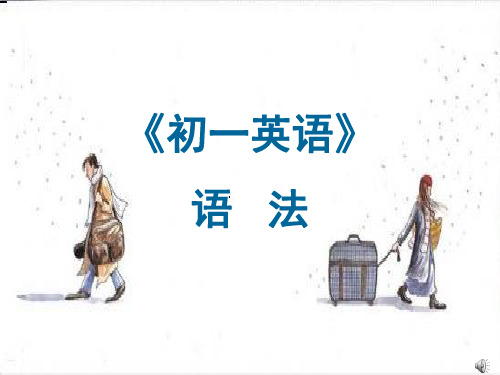
German.
双重所有格
所有’s格结的构形也式可以用于 “of”结构之后,如: a friend of
does
did
done doing
have learn
has learns
had
had having
learned /learnt
learned /learnt
learning
第三人称单数现在式
情况 变化规则
例词
一般情况
结尾为 s,x,sh,ch,o 结尾为辅音
字母+y
+s
+es 变y为 i+es
Be动词
am, is, are was, were
been
is 1.He ________ very good at English.
Practise
Were are 2.My father and I ________ going to Beijing next month.
was 3.________ you on duty the day before yesterday?
2. 在某些度量表示法中:
We have PE lessons three times a week.
3. 用在单数的表语名词前,以表示职业、行 业、宗教、等级等。
George wants to be an engineer.
4. 在以what引导的感叹句中,单数的可数名 词前。
七年级英语语法知识总结(精选6篇)
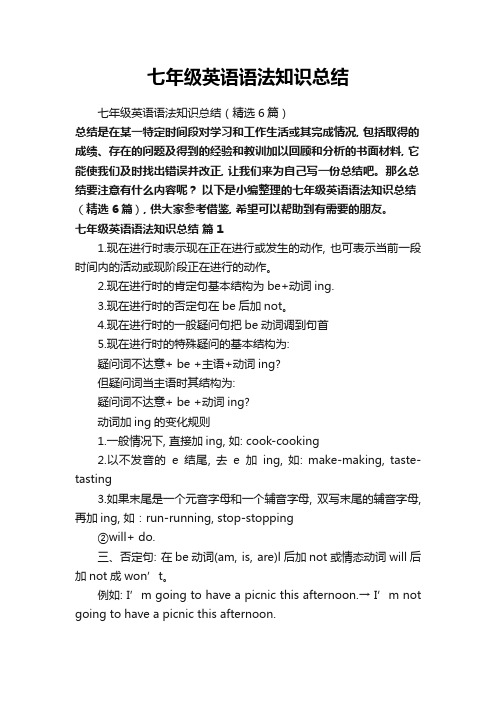
七年级英语语法知识总结七年级英语语法知识总结(精选6篇)总结是在某一特定时间段对学习和工作生活或其完成情况, 包括取得的成绩、存在的问题及得到的经验和教训加以回顾和分析的书面材料, 它能使我们及时找出错误并改正, 让我们来为自己写一份总结吧。
那么总结要注意有什么内容呢?以下是小编整理的七年级英语语法知识总结(精选6篇), 供大家参考借鉴, 希望可以帮助到有需要的朋友。
七年级英语语法知识总结篇11.现在进行时表示现在正在进行或发生的动作, 也可表示当前一段时间内的活动或现阶段正在进行的动作。
2.现在进行时的肯定句基本结构为be+动词ing.3.现在进行时的否定句在be后加not。
4.现在进行时的一般疑问句把be动词调到句首5.现在进行时的特殊疑问的基本结构为:疑问词不达意+ be +主语+动词ing?但疑问词当主语时其结构为:疑问词不达意+ be +动词ing?动词加ing的变化规则1.一般情况下, 直接加ing, 如: cook-cooking2.以不发音的e结尾, 去e加ing, 如: make-making, taste- tasting3.如果末尾是一个元音字母和一个辅音字母, 双写末尾的辅音字母, 再加ing, 如:run-running, stop-stopping②will+ do.三、否定句: 在be动词(am, is, are)l后加not或情态动词will后加not成won’t。
例如: I’m going to have a picnic this afternoon.→ I’m not going to have a picnic this afternoon.四、一般疑问句: be或will提到句首, some改为any, and改为or, 第一二人称互换。
例如: We are going to go on an outing this weekend.→ Are you going to go on an outing this weekend?五、对划线部分提问。
初一英语语法知识点大全

初一英语语法知识点大全一、初一英语语法——词法1、名词A、名词的数我们知道名词可以分为可数名词和不可数名词,而不可数名词它没有复数形式,但可数名词却有单数和复数之分,复数的构成如下:一在后面加s;如:fathers, books, Americans, Germans, apples, bananas二x, sh, ch, s, tch后加es;如:boxes, glasses, dresses, watches, wishes, faxes三1以辅音字母加y结尾的变y为i再加es 如:baby-babies, family-families, duty-duties, comedy-comedies, documentary-documentaries, story-stories2以元音字母加y结尾的直接加s;如:day-days, boy-boys, toy-toys, key-keys, ways 四以o结尾加s外来词;如:radios, photos, 但如是辅音加o的加es:如: tomatoes西红柿, potatoes马铃薯五以f或fe结尾的变f为v再加ess;如:knife-knives, wife-wives, half-halves, shelf-shelv es, leaf-leaves, yourself-yourselves六单复数相同不变的有:fish, sheep, deer鹿子, Chinese, Japanese七一般只有复数,没有单数的有:people,pants, shorts, shoes, glasses, gloves, clothes, so cks八单词形式不变,既可以是单数也可以是复数的有:police警察局,警察, class班,同学, family家,家庭成员九合成的复数一般只加主要名词,多数为后一个单词;如:action movie-action movies, pen p al-pen pals; 但如果是由man或woman所组成的合成词的复数则同时为复数;如:man doctor-men doctors, woman teacher-women teachers十有的单复数意思不同;如:fish鱼fishes鱼的种类, paper纸papers报纸,卷子,论文, work 工作works作品,工厂, glass玻璃glasses玻璃杯,眼镜, orange桔子水oranges橙子, light光线lights灯, people人peoples民族, time时间times时代, 次数, chicken 鸡肉chickens 小鸡十一单个字母的复数可以有两种形式直接加s或’s;如:Is I’s, Ks K’s;但如是缩略词则只加s;如:IDs, VCDs, SARs十二特殊形式的有:child-children, man-men, woman-women, foot-feet, mouse-mice, policeman-policemen, Englishman-EnglishmenB名词的格当我们要表示某人的什么东西或人时,我们就要使用所有格形式;构成如下:一单数在后面加’s;如:brother’s, Mike’s, teacher’s二复数以s结尾的直接在s后加’,如果不是以s结尾的与单数一样处理;如:Teachers’Day 教师节, classmates’; Children’s Day六一节, Women’s Day三八节三由and并列的名词所有时,如果是共同所有同一人或物时,只加最后一个’s,但分别拥有时却分别按单数形式处理;如:Mike and Ben’s room迈克和本的房间共住一间,Mike’s and Ben’s rooms迈克和本的房间各自的房间2、代词项目人称代词物主代词指示代词反身代词人称主格宾格形容词名词性第一人称单数I me my mine myself复数we us our ours ourselves第二人称单数you you your yours yourself复数you you your yours yourselves第三人称单数she her her hers herselfhe him his his himselfit it its its this that itself复数they them their theirs these those themselves3、动词A 第三人称单数当动词是第三人称单数时,动词应该像名词的单数变动词那样加s,如下:一一般在词后加s;如:comes, spells, waits, talks, sees, dances, trains二在x, sh, ch, s, tch后加es;如:watches, washes, wishes, finishes三1以辅音字母加y结尾的变y为i再加es;如:study-studies, hurry-hurries, try-tries 2以元音字母加y结尾的直接加s;如:plays, says, stays, enjoys, buys四以o结尾加es;如:does, goes五特殊的有:are-is, have-hasB 现在分词当我们说某人正在做什么事时,动词要使用分词形式,不能用原形,构成如下:一一般在后加ing;如:spell-spelling, sing-singing, see-seeing, train-training, play-playi ng, hurry-hurrying, watch-watching, go-going, do-doing二以不发音e的结尾的去掉e再加ing;如:dance-dancing, wake-waking, take-taking, pra ctice-practicing, write-writing, have-having三以重读闭音节结尾且一个元音字母+一个辅音字母注意除开字母组合如show –showing, dr aw-drawing要双写最后的辅音字母再加ing;如:put-putting, run-running, get-getting, let-let ting, begin-beginning四以ie结尾的变ie为y再加ing;如:tie-tying系die-dying死lie-lying 位于4、形容词的级我们在对两个或以上的人或物进行对比时,则要使用比较或最高级形式;构成如下:一一般在词后加er或est如果是以e结尾则直接加r或st;如:greater-greatest, shorter –s hortest, taller –tallest, longer –longest, nicer- nicest, larger -largest二以重读闭音节结尾且1个元音字母+1个辅音字母字母组合除外,如few-fewer fewest结尾的双写结尾的辅音再加er /est;如:big-bigger biggest, red-redder reddest, hot-hotter hottest 三以辅音字母+y结尾的变y为i加er/est;如:happy-happier happiest, sorry-sorrier sorr iest, friendly-friendlier friendliestmore friendly most friendly, busy-busier busiest, easy-easier easiest四特殊情况:两好多坏,一少老远good/well - better best many/much - more most bad/ill –worse worstlittle- less least old- older/elder oldest/eldest far- farther/further farthest/furthest5、数词基变序,有规则;一、二、三,自己背;五、八、九、十二;其它后接th;y结尾,变为i, eth跟上去; first, second, third; fifth, eighth, ninth, twelfth; seventh, tenth, thirteenth, hundred th; twenty-twentieth, forty-fortieth, ninety-ninetieth二、初一英语语法——句式1.陈述句肯定陈述句a This is a book. be动词b He looks very young. 连系动词c I want a sweat like this. 实义动词d I can bring some things to school. 情态动词e There’s a computer on my desk. There be结构否定陈述句a These aren’t their books. b They don’t look nice.c Kate doesn’t go to No. 4 Middle School.d Kate can’t find her doll.e There isn’t a cat here. =There’s no cat here.2. 祈使句肯定祈使句a Please go and ask the man. b Let’s learn Englishc Come in, please.否定祈使句a Don’t be late. b Don’t hurry.3. 疑问句1 一般疑问句a Is Jim a student b Can I help you c Does she like saladd Do they watch TVe Is she reading肯定回答: a Yes, he is. b Yes, you can. c Yes, she does. d Yes, they do. e Yes, she is.否定回答: a No, he isn’t. b No, you can’t. c No, she doesn’t. d No, they don’t.e No, she isn’t.2 选择疑问句Is the table big or small 回答It’s big./ It’s small.3 特殊疑问句①问年龄How old is Lucy She is twelve.②问种类What kind of movies do you like I like action movies and comedies.③问身体状况How is your uncle He is well/fine.④问方式How do/can you spell it L-double O-K.⑤问原因Why do you want to join the club⑥问时间What’s the time =What time is it It’s a quarter to ten ..What time do you usually get up, Rick At five o’clock.When do you want to go Let’s go at 7:00.⑦问地方Where’s my backpack It’s under the table.⑧问颜色What color are they They are light blue.What’s your favourite color It’s black.⑨问人物Who’s that It’s my sister.Who is the boy in blue My brother.Who isn’t at school Peter and Emma.Who are Lisa and Tim talking to⑩问东西What’s this/that in English It’s a pencil case.What else can you see in the picture I can see some broccoli, strawberries and h amburgers.11问姓名What’s your aunt’s name Her name is Helen./She’s Helen.What’s your first name My first name’s Ben.What’s your family name My family name’s Smith.12 问哪一个Which do you like I like one in the box.13 问字母What letter is it It’s big D/small f.14 问价格How much are these pants They’re 15 dollars.15 问电话号码What’s your phone number It’s 576-8349.16 问谓语动作What’s he doing He’s watching TV.17 问职业身份What do you do I’m a teacher.What’s your father He’s a doctor.三、初一英语语法——时态1、一般现在时表示普遍、经常性的或长期性的动作时使用一般现在时,它有:Be 动词:She’s a worker. Is she a worker She isn’t a worker.情态动词:I can play the piano. Can you play the piano I can’t play the piano.行为动词:They want to eat some tomatoes. Do they want to eat any tomatoes Th ey don’t want to eat any tomatoes.Gina has a nice watch. Does Gina have a nice watch Gina doesn’t have a watch.2、现在进行时表示动词在此时正在发生或进行就使用进行时态,结构为sb be v-ing sth + 其它.I’m playing baseball. Are you playing baseball I’m not playing baseball.Nancy is writing a letter. Is Nancy writing a letter Nancy isn’t writing a letter.They’re listening to the pop music. Are they listening the pop music They aren’t listening to the pop music.1. 形容词的用法:形容词用以修饰名词,表示人或事物的特征;在句中可以作定语、表语,用于限定被修饰语的特征,如长短、大小、重量、颜色、高矮、胖瘦、新旧等,;The little girl is very pretty. 这个小女孩很好看;--I want that one. 我想要那个;--Which one 哪一个--The new blue one. 那个蓝色新的;Can I have a look at the big nice one 我能看一看那个大的漂亮的吗2、人称代词:是用来表示人的代词,有单数和负数之分,有主格和宾格之分;人称代词的主格在句中作主语;人称代词的宾格在句中作宾语,是作动词或介词的宾语;主格:I, we, you, he, she, it, they在句子中作主语宾格:me, us, you, him, her, it, them在句子中作宾语He and I are in the same class. 我和他在同一个班级;Can you see them in the street 你能看见他们在街上吗3、可数名词和不可数名词英语中名词分为可数名词和不可数名词;凡是可数计数的名词叫做可数名词;凡是不可以计数的名词叫做不可数名词;1可数名词分为单数和复数两种形式;可数名词前可以用不定冠词、数词或some many等修饰;如:a man a desk an apple an orange some books some children tow pens 2不可数名词没有复数形式,前面不能用不定冠词、数词或many等词语修饰,但可以用some a little much等词语来修饰;有时可以与一些量词短语搭配,这些量词短语中的名词一般是可数的,有单数形式,也可以有复数形式;如:some water a little milk much food a piece of bread tow b ottles of ink some glasses of water4、祈使句祈使句用来表示请求、命令等,句中没有主语,肯定形式由谓语或者谓语+宾语+宾语补足语构成,否定形式则在句前加Don’t.Stand up, please. 请起立; Don’t worry. 别担心;can的用法:can是情态动词,表示“能,会,可以,被允许等”,其后接动词原形,否定形式为cannot,可缩写为ca n’t.She can speak Japanese. 她会讲日语;I can’t remember his name. 我不记得他的名字了;Can you spell your name 你会拼写你的名字吗5、现在进行时态:概念:表示现在说话瞬间正在进行或发生的动作,也可以表示目前一段时间内或现阶段正在进行的活动;结构:由be动词am, is, are + 动词ing构成,其中be动词要与主语保持性数一致;Mary is flying a kite in the park. 玛丽正在公园里放风筝;--What are you doing now 你现在在干什么--I’m reading English. 我正在读英语;Are they drawing the pictures now 他们正在画画吗动词现在分词是动词原形变化而来的,规则变化如下:动词ing形式叫动词现在分词,其构成如下:1 直接在动词后加ingplay—playing, do—doing, talk—talking, sing--singing2 以不发音的字母e结尾的动词,先去e,再加ingmake—making, write—writing, have—having, take—taking3 以重读闭音节结尾的动词且词尾只有一个辅音字母,应双写这个辅音字母,再加ingrun—running, stop—stopping, put—putting, swim—swimming注意对现在进行时态的判断;判断一个英语句子用什么时态,主要看句子的时间状语,一般说来,每种时态都有与之相对应的时间状语;现在进行时表示现在说话瞬间正在进行或发生的动作;因此,这个时态最常用的时间状语是now;但有不少句子并没有now,只能通过提示语如look、listen等或者通过上下文来确定用现在进行时;She is cleaning her room now. 她正在打扫房间;Look The girl is dancing over there. 看那个女孩在那里跳舞;Can you go and play games with me 你能和我们一起做游戏吗Can’t you see I am doing my homework 你没看见我正在做作业吗6、have/ has的用法:1 谓语动词have表示“有”,有两种形式:have和has,前者用于第一人称I, we,第二人称you 和第三人称复数they,后者用于第三人称单数he, she, it或单数名词;I have an apple and he has two bananas. 我有一个苹果,他有两个香蕉;You have a new English teacher. 你们有了一个新的英语老师;It has two big eyes. 它有一双大眼睛;Julie and Jack have a nice car. 朱莉和杰克有一辆好看的车;2 have/has句型与there be句型的比较:两者都表示“有”,但用法不同;前者表示所属关系,即表示“某人或某物有什么”,而后者表示存在,表示“某地有什么”;They have some new books. 他们有一些新书;There are some new books on their desks. 他们桌子上有一些新书;She has a lot of pretty skirts. 她有很多漂亮的裙子;There are a lot of pretty skirts in the shop. 商店里有很多漂亮的裙子;3 have/ has的否定句,一般要加助动词do/ does,再加not构成,即do not have don’t ha ve/ does not have doesn’t have. She does not have a sister. 她没有姐姐;We don’t have any classes on Saturday. 我们星期六没有课;Ann and I don’t have a big room. 我和安没有一个大房间;4 一般疑问句由“助动词Do/ Does + 主语+ have + 宾语”构成,回答用Yes, …do/ doe s.或者No, …don’t/ doesn’t.--Do you have a big house 他们的房子大吗--No, they don’t. 不,他们的房子不大;--Does he have an eraser 他有橡皮吗--Yes, he does. 他有的;5 特殊疑问句由特殊疑问词+ 助动词do/ does + have +状语构成;What do they have 他们有什么What does he have 他有什么How many telephones do they have 他们有几部电话7、介词用法:1 具体时间前介词用at;. He gets up at half past seven every day. 他每天七点半起床;She goes to bed at eleven o’clock. 她十一点睡觉;2 表示“在早上,在下午,在晚上”的短语中用介词in,且定冠词the不能省略;表示“在中午,在夜里”的短语中介词用at,不加冠词;in the morning在早上,in the afternoon 在下午,in the evening 在晚上at noon在中午,at night在夜里3 表示“在某天”、“在某天的上午、下午等”的短语用介词on;What do you usually do on Monday morning 星期一上午你通常做什么Do you sometimes go out to eat on Friday evening 有时你星期五晚上出去吃饭吗He watches DVDs on Saturday night. 星期六晚上他看DVD;Parents take children to parks on June 1. 六月一日,家长们带着孩子去公园;4 在this, last, next, every等词前面既不加介词,也不用冠词;What are you doing this afternoon 今天下午你做什么He visits his grandma every Friday. 他每个星期五都去看望祖母;She is going to Shanghai next Monday. 她下个星期一去上海;8、一般现在时一般现在时表示经常性或习惯性的动作,或表示现在的特征或状态;其动词形式是:动词原形只有第三人称单数作主语时除外,要加-s其疑问句和否定句需要用助动词do或does1 肯定句用行为动词原形表示They get up very early every morning. 他们每天早晨起来很早;I visit my grandparents four times a month. 我一个月去看望祖父母四次;2 否定句用don’t + 动词原形来表示We do not go shopping on Sundays. 我们周日不去购物;I don’t think you like this colour. 我想你不喜欢这个颜色;3 一般疑问句则是把助动词do提前至句首,后面动词用原形;回答时,肯定用“Yes, 主语+do”;否定句用“No, 主语+don’t”;–Do they go to school at seven o’clock 他们七点去上学吗--Yes, they do.--Do you like this skirt 你喜欢这条裙子吗--No, I don’t. 不,我不喜欢;一般现在时用来表示经常的或习惯性的动作,常与以下的时间状语连用:often 经常,always 总是, sometimes 有时,usually 通常,every day/ week 每天/ 周等;He usually goes to school by bike. 通常他骑车上学;I visit my grandparents every week. 我每个星期都去看祖父母;She is always late for class. 她总是上课迟到;My parents and I sometimes go out to eat. 我和父母有时出去吃饭;It often rains here. 这儿常常下雨;主语为第三人称单数时的一般现在时一般现在时态,当主语为第三人称单数时,谓语动词也要是第三人称单数,后要加-s或-es;He likes reading at night. 他喜欢夜里读书;She usually goes to school by bike. 她平时骑车上学;The little cat drinks milk every day. 小猫每天都喝牛奶;转换成否定句要加doesn’t,其后的动词用原形;Kelly doesn’t get up early on Saturdays and Sundays. 凯丽星期六星期天起床不早;He doesn’t feel well today. 他今天感觉不舒服;转换成一般疑问句,句首用Does,其后的动词用原形;Does he have lunch at school 他在学校吃午饭吗Does it take long by train 乘火车要很长时间吗初一英语语法重点总结2初一的语法知识包括:主要掌握几种时态1,一般现在时2,一般过去时3,一般将来时4,现在进行时还有几种词1,名词2,代词3,形容词4,动词5,冠词初一英语语法一、词法1、名词A、名词的数我们知道名词可以分为可数名词和不可数名词,而不可数名词它没有复数形式,但可数名词却有单数和复数之分,复数的构成如下:一在后面加s;如:fathers, books, Americans, Germans, apples, bananas二x, sh, ch, s, tch后加es;如:boxes, glasses, dresses, watches, wishes, faxes三1以辅音字母加y结尾的变y为i再加es 如:baby-babies, family-families, duty-dutie s, comedy-comedies, documentary-documentaries, story-stories2以元音字母加y结尾的直接加s;如:day-days, boy-boys, toy-toys, key-keys, ways 四以o结尾加s外来词;如:radios, photos, 但如是辅音加o的加es:如: tomatoes西红柿, potatoes马铃薯五以f或fe结尾的变f为v再加ess;如:knife-knives, wife-wives, half-halves, shelf-shelv es, leaf-leaves, yourself-yourselves六单复数相同不变的有:fish, sheep, deer鹿子, Chinese, Japanese七一般只有复数,没有单数的有:people, pants, shorts, shoes, glasses, gloves, clothes, s ocks八单词形式不变,既可以是单数也可以是复数的有:police警察局,警察, class班,同学, family家,家庭成员九合成的复数一般只加主要名词,多数为后一个单词;如:action movie-action movies, pen p al-pen pals; 但如果是由man或woman所组成的合成词的复数则同时为复数;如:man doctor-men doctors, woman teacher-women teachers十有的单复数意思不同;如:fish鱼fishes鱼的种类, paper纸papers报纸,卷子,论文, work 工作works作品,工厂, glass玻璃glasses玻璃杯,眼镜, orange桔子水oranges橙子, light光线lights灯, people人peoples民族, time时间times时代, 次数, chicken 鸡肉chickens 小鸡十一单个字母的复数可以有两种形式直接加s或’s;如:Is I’s, Ks K’s;但如是缩略词则只加s;如:IDs, VCDs, SARs十二特殊形式的有:child-children, man-men, woman-women, foot-feet, mouse-mice, policeman-policemen, Englishman-EnglishmenB名词的格当我们要表示某人的什么东西或人时,我们就要使用所有格形式;构成如下:一单数在后面加’s;如:brother’s, Mike’s, teacher’s二复数以s结尾的直接在s后加’,如果不是以s结尾的与单数一样处理;如:Teachers’Day 教师节, classmates’; Children’s Day六一节, Women’s Day三八节三由and并列的名词所有时,如果是共同所有同一人或物时,只加最后一个’s,但分别拥有时却分别按单数形式处理;如:Mike and Ben’s room迈克和本的房间共住一间,Mike’s and Ben’s rooms迈克和本的房间各自的房间2、代词项目人称代词物主代词指示代词反身代词人称主格宾格形容词名词性第一人称单数I me my mine myself复数we us our ours ourselves第二人称单数you you your yours yourself复数you you your yours yourselves第三人称单数she her her hers herselfhe him his his himselfit it its its this that itself复数they them their theirs these those themselves3、动词A 第三人称单数当动词是第三人称单数时,动词应该像名词的单数变动词那样加s,如下:一一般在词后加s;如:comes, spells, waits, talks, sees, dances, trains二在x, sh, ch, s, tch后加es;如:watches, washes, wishes, finishes三1以辅音字母加y结尾的变y为i再加es;如:study-studies, hurry-hurries, try-tries 2以元音字母加y结尾的直接加s;如:plays, says, stays, enjoys, buys四以o结尾加es;如:does, goes五特殊的有:are-is, have-hasB 现在分词当我们说某人正在做什么事时,动词要使用分词形式,不能用原形,构成如下:一一般在后加ing;如:spell-spelling, sing-singing, see-seeing, train-training, play-playi ng, hurry-hurrying, watch-watching, go-going, do-doing二以不发音e的结尾的去掉e再加ing;如:dance-dancing, wake-waking, take-taking, pra ctice-practicing, write-writing, have-having三以重读闭音节结尾且一个元音字母+一个辅音字母注意除开字母组合如show –showing, dr aw-drawing要双写最后的辅音字母再加ing;如:put-putting, run-running, get-getting, let-let ting, begin-beginning四以ie结尾的变ie为y再加ing;如:tie-tying系die-dying死lie-lying 位于4、形容词的级我们在对两个或以上的人或物进行对比时,则要使用比较或最高级形式;构成如下:一一般在词后加er或est如果是以e结尾则直接加r或st;如:greater-greatest, shorter –s hortest, taller –tallest, longer –longest, nicer- nicest, larger -largest二以重读闭音节结尾且1个元音字母+1个辅音字母字母组合除外,如few-fewer fewest结尾的双写结尾的辅音再加er /est;如:big-bigger biggest, red-redder reddest, hot-hotter hottest 三以辅音字母+y结尾的变y为i加er/est;如:happy-happier happiest, sorry-sorrier sorr iest, friendly-friendlier friendliestmore friendly most friendly, busy-busier busiest, easy-easier easiest四特殊情况:两好多坏,一少老远good/well - better best many/much - more most bad/ill –worse worstlittle- less least old- older/elder oldest/eldest far- farther/further farthest/furthest5、数词基变序,有规则;一、二、三,自己背;五、八、九、十二;其它后接th;y结尾,变为i, eth跟上去; first, second, third; fifth, eighth, ninth, twelfth; seventh, tenth, thirteenth, hundred th; twenty-twentieth, forty-fortieth, ninety-ninetieth二、句式1.陈述句肯定陈述句a This is a book. be动词b He looks very young. 连系动词c I want a sweat like this. 实义动词d I can bring some things to school. 情态动词e There’s a computer on my desk. There be结构否定陈述句a These aren’t their books. b They don’t look nice.c Kate doesn’t go to No. 4 Middle School.d Kate can’t find her doll.e There isn’t a cat here. =There’s no cat here.2. 祈使句肯定祈使句a Please go and ask the man. b Let’s learn Englishc Come in, please.否定祈使句a Don’t be late. b Don’t hurry.3. 疑问句1 一般疑问句a Is Jim a student b Can I help you c Does she like saladd Do they watch TVe Is she reading肯定回答: a Yes, he is. b Yes, you can. c Yes, she does. d Yes, they do. e Yes, she is.否定回答: a No, he isn’t. b No, you can’t. c No, she doesn’t. d No, they don’t.e No, she isn’t.2 选择疑问句Is the table big or small 回答It’s big./ It’s small.3 特殊疑问句①问年龄How old is Lucy She is twelve.②问种类What kind of movies do you like I like action movies and comedies.③问身体状况How is your uncle He is well/fine.④问方式How do/can you spell it L-double O-K.⑤问原因Why do you want to join the club⑥问时间What’s the time =What time is it It’s a quarter to ten ..What time do you usually get up, Rick At five o’clock.When do you want to go Let’s go at 7:00.⑦问地方Where’s my backpack It’s under the table.⑧问颜色What color are they They are light blue.What’s your favourite color It’s black.⑨问人物Who’s that It’s my sister.Who is the boy in blue My brother.Who isn’t at school Peter and Emma.Who are Lisa and Tim talking to⑩问东西What’s this/that in English It’s a pencil case.What else can you see in the picture I can see some broccoli, strawberries and h amburgers.11问姓名What’s your aunt’s name Her name is Helen./She’s Helen.What’s your first name My first name’s Ben.What’s your family name My family name’s Smith.12 问哪一个Which do you like I like one in the box.13 问字母What letter is it It’s big D/small f.14 问价格How much are these pants They’re 15 dollars.15 问电话号码What’s your phone number It’s 576-8349.16 问谓语动作What’s he doing He’s watching TV.17 问职业身份What do you do I’m a teacher.What’s your father He’s a doctor.三、时态1、一般现在时表示普遍、经常性的或长期性的动作时使用一般现在时,它有:Be 动词:She’s a worker. Is she a worker She isn’t a worker.情态动词:I can play the piano. Can you play the piano I can’t play the piano.行为动词:They want to eat some tomatoes. Do they want to eat any tomatoes Th ey don’t want to eat any tomatoes.Gina has a nice watch. Does Gina have a nice watch Gina doesn’t have a watch.2、现在进行时表示动词在此时正在发生或进行就使用进行时态,结构为sb be v-ing sth +其它.I’m playing baseball. Are you playing baseball I’m not playing baseball.Nancy is writing a letter. Is Nancy writing a letter Nancy isn’t writing a letter.They’re listening to the pop music. Are they listening the pop music They aren’t listening to the pop music.。
七年级英语全册所有语法知识点
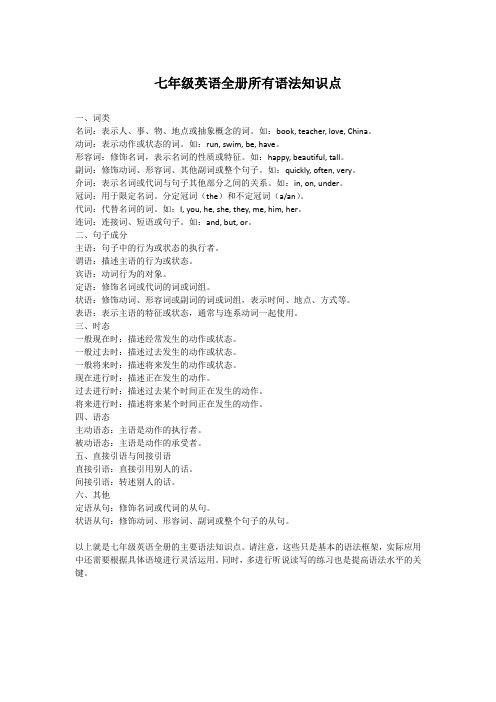
七年级英语全册所有语法知识点一、词类名词:表示人、事、物、地点或抽象概念的词。
如:book, teacher, love, China。
动词:表示动作或状态的词。
如:run, swim, be, have。
形容词:修饰名词,表示名词的性质或特征。
如:happy, beautiful, tall。
副词:修饰动词、形容词、其他副词或整个句子。
如:quickly, often, very。
介词:表示名词或代词与句子其他部分之间的关系。
如:in, on, under。
冠词:用于限定名词。
分定冠词(the)和不定冠词(a/an)。
代词:代替名词的词。
如:I, you, he, she, they, me, him, her。
连词:连接词、短语或句子。
如:and, but, or。
二、句子成分主语:句子中的行为或状态的执行者。
谓语:描述主语的行为或状态。
宾语:动词行为的对象。
定语:修饰名词或代词的词或词组。
状语:修饰动词、形容词或副词的词或词组,表示时间、地点、方式等。
表语:表示主语的特征或状态,通常与连系动词一起使用。
三、时态一般现在时:描述经常发生的动作或状态。
一般过去时:描述过去发生的动作或状态。
一般将来时:描述将来发生的动作或状态。
现在进行时:描述正在发生的动作。
过去进行时:描述过去某个时间正在发生的动作。
将来进行时:描述将来某个时间正在发生的动作。
四、语态主动语态:主语是动作的执行者。
被动语态:主语是动作的承受者。
五、直接引语与间接引语直接引语:直接引用别人的话。
间接引语:转述别人的话。
六、其他定语从句:修饰名词或代词的从句。
状语从句:修饰动词、形容词、副词或整个句子的从句。
以上就是七年级英语全册的主要语法知识点。
请注意,这些只是基本的语法框架,实际应用中还需要根据具体语境进行灵活运用。
同时,多进行听说读写的练习也是提高语法水平的关键。
初一英语语法大全

初一英语语法大全1. 词性(1)名词(Noun):表示人、物、地点、动物等具体或抽象的事物。
名词可以用来表示主语、宾语、定语和补语等。
例句:I have a book.(我有一本书)(2)代词(Pronoun):代替名词的词语,用于避免重复,分为人称代词、物主代词、指示代词、疑问代词和不定代词等。
例句:He is my friend.(他是我的朋友)(3)动词(Verb):表示动作、状态或存在的词语。
分为及物动词和不及物动词。
例句:I like playing basketball.(我喜欢打篮球)(4)形容词(Adjective):修饰名词或代词,描述它们的性质或特征。
例句:She has a beautiful dress.(她有一件漂亮的裙子)(5)副词(Adverb):修饰动词、形容词、副词等,描述它们的程度、方式、时间等。
例句:He speaks English fluently.(他讲英语流利)(6)介词(Preposition):表示方位、时间、方式等概念,连接名词或代词与其他词语。
例句:She is studying in the library.(她正在图书馆学习)(7)连词(Conjunction):连接词、短语或从句,表示逻辑关系。
例句:I want to go to the park, but it's raining.(我想去公园,但是下雨了)(8)感叹词(Interjection):表示强烈的情感或意思的词语。
例句:Oh no! I forgot my keys.(哦,不!我忘记带钥匙了)2. 句子成分(1)主语(Subject):句子中执行动作的主要对象,通常是名词、代词、动名词短语等。
例句:Tom is playing football.(汤姆在踢足球)(2)谓语(Predicate):句子中说明主语动作或状态的部分,通常是动词或动词短语。
例句:She likes to read books.(她喜欢读书)(3)宾语(Object):句子中接受动作的对象,通常是名词、代词等。
初一英语所有语法知识点总结归纳

初一英语所有语法知识点总结归纳初一英语是英语学习的基础阶段,语法作为英语学习的核心部分,需要我们进行深入理解和掌握。
本文将详细总结初一英语的所有语法知识点,帮助大家更好地理解和应用这些语法规则。
一、一般现在时一般现在时是初一英语中最基本的时态之一,主要用于表示经常性、习惯性或客观存在的动作或状态。
其主要形式是主语+谓语(动词原形),但有时会通过添加助动词或情态动词进行变化。
1. 肯定句:主语+动词原形(第三人称单数加s/es)+其他。
2. 否定句:主语+ don't/doesn't+动词原形+其他。
3. 疑问句:Do/Does+主语+动词原形+其他?例如:He goes to school every day.(他每天上学。
)肯定句的否定形式可以在助动词 do/does 后加 not 构成don't/doesn't。
疑问句需要将助动词 Do/Does 放在句首。
二、现在进行时现在进行时用于描述当前正在发生的事情或正在进行的动作,具有强调当前和生动形象的特点。
其形式为主语+ am/is/are +动词的现在分词+其他。
1. 肯定句:主语+ am/is/are +动词的现在分词+其他。
2. 否定句:主语+ am/is/are + not +动词的现在分词+其他。
3. 疑问句:Are/Is + 主语+动词的现在分词+其他?例如:They are playing football now.(他们正在踢足球。
)否定句和疑问句的构成与一般现在时相似,只是在 be 动词后添加了 not 或 are/is/am。
三、一般过去时一般过去时表示过去某个时间发生的事情,常与表示过去的时间状语连用,如 yesterday,last week 等。
其形式为主语+谓语(动词的过去式),be 动词的过去式也可以用于表示过去的状态或事实。
1. 肯定句:主语+谓语(动词的过去式)+其他。
2. 否定句:主语+ didn't +谓语(动词的原形)+其他。
七年级英语语法大全

七年级英语语法大全【一般现在时】.概念:经常、反复发生的动作或行为及现在的某种状况。
动词用原形(单三人称动词加s / es)(问句和否定句借用助词do / does)【一般过去时】概念:过去某个时间里发生的动作或状态;过去习惯性、经常性的动作、行为。
动词用过去式(问句和否定句借用助词did)【现在进行时】概念:表示现阶段或说话时正在进行的动作及行为。
am +动词-ingis +动词-ingare +动词-ing【过去进行时】概念:表示过去某段时间或某一时刻正在发生或进行的行为或动作。
was +动词-ingwere +动词-ing【一般将来时】概念:以过去某个时间为标准,在此以前发生的动作或行为,或在过去某动作之前完成的行为,即“过去的过去”。
(1)will + 动词原形(2)am +going to+动词原形Is +going to+动词原形are +going to+动词原形【过去将来时】概念:立足于过去某一时刻,从过去看将来,常用于宾语从句中。
(1)would + 动词原形(2)was +going to+动词原形were +going to+动词原形【现在完成时】概念:过去发生或已经完成的动作对现在造成的影响或结果,或从过去已经开始,持续到现在的动作或状态。
have +过去分词has +过去分词【过去完成时】概念:以过去某个时间为标准,在此以前发生的动作或行为,或在过去某动作之前完成的行为,即“过去的过去”。
had +过去分词1. 不定式定义:由to+动词原形构成。
不定式是一种非限定性动词。
而非限定动词是指那些在句中不能单独充当谓语的动词,可分为不定式,动名词,现在分词和过去分词。
2.用途:在句中不能作谓语。
它具有动词的性质,本身可以带宾语和状语。
【动词不定式】1.定义:动词 + 不定式2.用途:动词不定式在句中可以作句子任何成分。
动词不定式的被动形式除了一般形式外还有其完成式和进行式。
[编辑本段][动词不定式的时态、语态]动词不定式可以作以上各种成分,但它毕竟是动词,所以有动词的属性动词不定式及其短语还可以有自己的宾语、状语,虽然动词不定式在语法上没有表面上的直接主语,但它表达的意义是动作,这一动作一定由使动者发出。
初一英语语法知识点
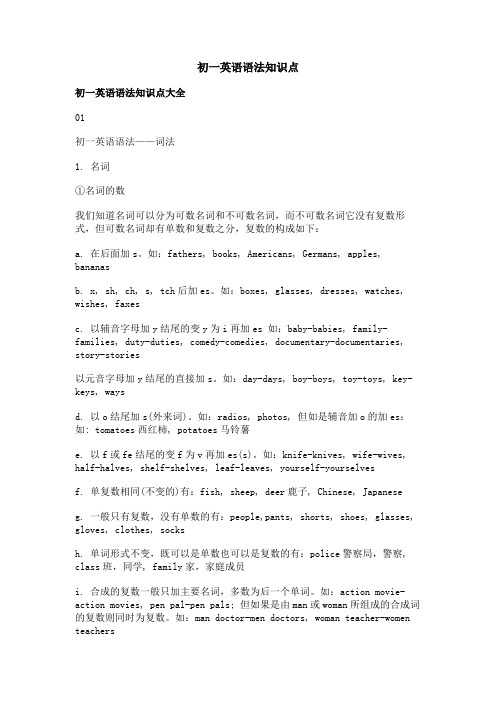
初一英语语法知识点初一英语语法知识点大全01初一英语语法——词法1. 名词①名词的数我们知道名词可以分为可数名词和不可数名词,而不可数名词它没有复数形式,但可数名词却有单数和复数之分,复数的构成如下:a. 在后面加s。
如:fathers, books, Americans, Germans, apples, bananasb. x, sh, ch, s, tch后加es。
如:boxes, glasses, dresses, watches, wishes, faxesc. 以辅音字母加y结尾的变y为i再加es 如:baby-babies, family-families, duty-duties, comedy-comedies, documentary-documentaries, story-stories以元音字母加y结尾的直接加s。
如:day-days, boy-boys, toy-toys, key-keys, waysd. 以o结尾加s(外来词)。
如:radios, photos, 但如是辅音加o的加es:如: tomatoes西红柿, potatoes马铃薯e. 以f或fe结尾的变f为v再加es(s)。
如:knife-knives, wife-wives, half-halves, shelf-shelves, leaf-leaves, yourself-yourselvesf. 单复数相同(不变的)有:fish, sheep, deer鹿子, Chinese, Japaneseg. 一般只有复数,没有单数的有:people,pants, shorts, shoes, glasses, gloves, clothes, socksh. 单词形式不变,既可以是单数也可以是复数的有:police警察局,警察, class班,同学, family家,家庭成员i. 合成的复数一般只加主要名词,多数为后一个单词。
七年级英语知识点梳理

七年级英语知识点梳理一、语法知识点。
1. 一般现在时。
- 概念:表示经常或习惯性的动作或状态,也表示客观事实或普遍真理。
- 结构:- 肯定句:- 主语为第三人称单数(he/she/it等)时,动词要用第三人称单数形式(一般在动词原形后加 -s或 -es)。
例如:He likes reading.- 主语为第一人称(I)、第二人称(you)、复数(we/they等)时,动词用原形。
例如:I like apples.- 否定句:- 主语为第三人称单数时,借助助动词doesn't,动词还原为原形。
例如:He doesn't like running.- 主语为第一人称、第二人称、复数时,借助助动词don't,动词用原形。
例如:We don't go to school on Sundays.- 一般疑问句:- 主语为第三人称单数时,将Does提前,动词还原为原形。
例如:Does she play the piano?- 主语为第一人称、第二人称、复数时,将Do提前。
例如:Do you like English?2. 名词的复数形式。
- 规则变化:- 一般情况在词尾加 -s,如book - books。
- 以s, x, ch, sh结尾的名词,词尾加 -es,如box - boxes。
- 以辅音字母 + y结尾的名词,把y变为i,再加 -es,如baby - babies。
- 以f或fe结尾的名词,把f或fe变为v,再加 -es,如knife - knives(也有一些直接加 -s的特例,如roofs)。
- 不规则变化:- 单复数同形,如fish(表示鱼的种类时复数为fishes)、sheep、deer等。
- 特殊变化,如man - men,woman - women,child - children等。
3. 形容词性物主代词和名词性物主代词。
- 形容词性物主代词:my(我的)、your(你的/你们的)、his(他的)、her (她的)、its(它的)、our(我们的)、their(他们的)。
- 1、下载文档前请自行甄别文档内容的完整性,平台不提供额外的编辑、内容补充、找答案等附加服务。
- 2、"仅部分预览"的文档,不可在线预览部分如存在完整性等问题,可反馈申请退款(可完整预览的文档不适用该条件!)。
- 3、如文档侵犯您的权益,请联系客服反馈,我们会尽快为您处理(人工客服工作时间:9:00-18:30)。
初一英语全册语法知识点汇总当我第一遍读一本好书的时候,我仿佛觉得找到了一个朋友;当我再一次读这本书的时候,仿佛又和老朋友重逢。
我们要把读书当作一种乐趣,并自觉把读书和学习结合起来,做到博览、精思、熟读,更好地指导自己的学习,让自己不断成长。
让我们一起到学习啦一起学习吧!初一英语语法大全初一英语语法虽然是从简单的一些日常用语出发的,但语法中常会有一些知识点看起来很细小,容易被忽视,但这些知识点掌握不熟练,往往会造成一些语法应用上的错误。
因此在学习初一英语语法时,要认真、细心,不要觉得一些地方不重要而得过且过。
下面从几个方面,总结出了初一英语语法,如果要复习英语句法的同学,可以参考一下,一、初一英语语法——词法1、名词A)、名词的数我们知道名词可以分为可数名词和不可数名词,而不可数名词它没有复数形式,但可数名词却有单数和复数之分,复数的构成如下:一)在后面加s。
如:fathers, books, Americans, Germans, apples, bananas二)x, sh, ch, s, tch后加es。
如:boxes, glasses, dresses, watches, wishes, faxes三)1)以辅音字母加y结尾的变y为i再加es 如:baby-babies, family-families, duty-duties, comedy-comedies, documentary-documentaries, story-stories2)以元音字母加y结尾的直接加s。
如:day-days, boy-boys, toy-toys, key-keys, ways四)以o结尾加s(外来词)。
如:radios, photos, 但如是辅音加o的加es:如: tomatoes西红柿, potatoes马铃薯五)以f或fe结尾的变f为v再加es(s)。
如:knife-knives, wife-wives, half-halves, shelf-shelves, leaf-leaves, yourself-yourselves六)单复数相同(不变的)有:fish, sheep, deer鹿子, Chinese, Japanese七)一般只有复数,没有单数的有:people,pants, shorts, shoes, glasses, gloves, clothes, socks八)单词形式不变,既可以是单数也可以是复数的有:police警察局,警察, class 班,同学, family家,家庭成员九)合成的复数一般只加主要名词,多数为后一个单词。
如:action movie-action movies, pen pal-pen pals; 但如果是由man或woman所组成的合成词的复数则同时为复数。
如:man doctor-men doctors, woman teacher-women teachers十)有的单复数意思不同。
如:fish鱼 fishes鱼的种类, paper纸 papers报纸,卷子,论文, work工作 works作品,工厂, glass玻璃 glasses玻璃杯,眼镜, orange桔子水 oranges橙子, light光线 lights灯, people人 peoples民族, time时间 times时代, 次数, chicken 鸡肉 chickens 小鸡十一) 单个字母的复数可以有两种形式直接加s或’s。
如:Is (I’s), Ks (K’s)。
但如是缩略词则只加s。
如:IDs, VCDs, SARs十二) 特殊形式的有:child-children, man-men, woman-women, foot-feet, mouse-mice, policeman-policemen, Englishman-EnglishmenB)名词的格当我们要表示某人的什么东西或人时,我们就要使用所有格形式。
构成如下:一)单数在后面加’s。
如:brother’s, Mike’s, teacher’s二)复数以s结尾的直接在s后加’,如果不是以s结尾的与单数一样处理。
如:Teachers’ Day教师节, classmates’; Children’s Day六一节, Women’s Day三八节三)由and并列的名词所有时,如果是共同所有同一人或物时,只加最后一个’s,但分别拥有时却分别按单数形式处理。
如:Mike and Ben’s room迈克和本的房间(共住一间),Mike’s and Ben’s rooms迈克和本的房间(各自的房间)2、代词项目人称代词物主代词指示代词反身代词人称主格宾格形容词名词性第一人称单数 I me my mine myself复数 we us our ours ourselves第二人称单数 you you your yours yourself复数 you you your yours yourselves第三人称单数 she her her hers herselfhe him his his himselfit it its its this that itself复数 they them their theirs these those themselves3、动词A) 第三人称单数当动词是第三人称单数时,动词应该像名词的单数变动词那样加s,如下:一)一般在词后加s。
如:comes, spells, waits, talks, sees, dances, trains二)在x, sh, ch, s, tch后加es。
如:watches, washes, wishes, finishes三)1)以辅音字母加y结尾的变y为i再加es。
如:study-studies, hurry-hurries, try-tries2)以元音字母加y结尾的直接加s。
如:plays, says, stays, enjoys, buys四)以o结尾加es。
如:does, goes五)特殊的有:are-is, have-hasB) 现在分词当我们说某人正在做什么事时,动词要使用分词形式,不能用原形,构成如下:一)一般在后加ing。
如:spell-spelling, sing-singing, see-seeing, train-training, play-playing, hurry-hurrying, watch-watching, go-going, do-doing二)以不发音e的结尾的去掉e再加ing。
如:dance-dancing, wake-waking, take-taking, practice-practicing, write-writing, have-having三)以重读闭音节结尾且一个元音字母+一个辅音字母(注意除开字母组合如show –showing, draw-drawing)要双写最后的辅音字母再加ing。
如:put-putting, run-running, get-getting, let-letting, begin-beginning四)以ie结尾的变ie为y再加ing。
如:tie-tying系 die-dying死 lie-lying 位于4、形容词的级我们在对两个或以上的人或物进行对比时,则要使用比较或最高级形式。
构成如下:一) 一般在词后加er或est(如果是以e结尾则直接加r或st)。
如:greater-greatest, shorter –shortest, taller –tallest, longer –longest, nicer- nicest, larger -largest二)以重读闭音节结尾且1个元音字母+1个辅音字母(字母组合除外,如few-fewer fewest)结尾的双写结尾的辅音再加er /est。
如:big-bigger biggest, red-redder reddest, hot-hotter hottest三) 以辅音字母+y结尾的变y为i加er/est。
如:happy-happier happiest, sorry-sorrier sorriest, friendly-friendlier friendliest(more friendly most friendly), busy-busier busiest, easy-easier easiest四)特殊情况:(两好多坏,一少老远)good/well - better best many/much - more most bad/ill – worse worstlittle- less least old- older/elder oldest/eldest far- farther/further farthest/furthest5、数词(基变序,有规则;一、二、三,自己背;五、八、九、十二;其它后接th;y 结尾,变为i, eth跟上去。
) first, second, third; fifth, eighth, ninth, twelfth; seventh, tenth, thirteenth, hundredth; twenty-twentieth, forty-fortieth, ninety-ninetieth二、初一英语语法——句式1.陈述句肯定陈述句 a) This is a book. (be动词)b) He looks very young. (连系动词)c) I want a sweat like this. (实义动词)d) I can bring some things to school. (情态动词)e) There’s a computer on my desk. (There be结构)否定陈述句a) These aren’t their books. b) They don’t look nice.c) Kate doesn’t go to No. 4 Middle School. d) Kate can’t find her doll.e) There isn’t a cat here. (=There’s no cat here.)2. 祈使句肯定祈使句a) Please go and ask the man. b) Let’s learn English!c) Come in, please.否定祈使句a) Don’t be late. b) Don’t hurry.3. 疑问句1) 一般疑问句 a) Is Jim a student? b) Can I help you? c) Does she like salad?d) Do they watch TV? e) Is she reading?肯定回答: a) Yes, he is. b) Yes, you can. c) Yes, she does. d) Yes, they do. e) Yes, she is.否定回答: a) No, he isn’t. b) No, you can’t. c) No, she doesn’t. d) No, they don’t.e) No, she isn’t.2) 选择疑问句 Is the table big or small? 回答It’s big./ It’s small.3) 特殊疑问句①问年龄 How old is Lucy? She is twelve.②问种类 What kind of movies do you like? I like action movies and comedies.③问身体状况 How is your uncle? He is well/fine.④问方式 How do/can you spell it? L-double O-K.Howdowecontactyou?***********************************.⑤问原因 Why do you want to join the club?⑥问时间What’s the time? (=What time is it?) It’s a quarter to ten a.m..What time do you usually get up, Rick? At five o’clock.When do you want to go? Let’s go at 7:00.⑦问地方Where’s my backpack? It’s under the table.⑧问颜色 What color are they? They are light blue.What’s your favourite color? It’s black.⑨问人物Who’s that? It’s my sister.Who is the boy in blue? My brother.Who isn’t at school? Peter and Emma.Who are Lisa and Tim talking to?⑩问东西What’s this/that (in English)? It’s a pencil case.What else can you see in the picture? I can see some broccoli, strawberries and hamburgers.11问姓名What’s your aunt’s name? Her name is Helen./She’s Helen.What’s your first name? My first name’s Ben.What’s your family name? My family name’s Smith.12 问哪一个 Which do you like? I like one in the box.13 问字母What letter is it? It’s big D/small f.14 问价格How much are these pants? They’re 15 dollars.15 问电话号码What’s your phone number? It’s 576-8349.16 问谓语(动作) What’s he doing? He’s watching TV.17 问职业(身份) What do you do? I’m a teacher.What’s your father? He’s a doctor.三、初一英语语法——时态1、一般现在时表示普遍、经常性的或长期性的动作时使用一般现在时,它有:Be 动词:She’s a worker. Is she a worker? She isn’t a worker.情态动词:I can play the piano. Can you play the piano? I can’t play the piano.行为动词:They want to eat some tomatoes. Do they want to eat any tomatoes? They don’t want to eat any tomatoes.Gina has a nice watch. Does Gina have a nice watch? Gina doesn’t have a watch.2、现在进行时表示动词在此时正在发生或进行就使用进行时态,结构为sb be v-ing sth + 其它.I’m playing baseball. Are you playing baseball? I’m not playing baseball.Nancy is writing a letter. Is Nancy writing a letter? Nancy isn’t writing a letter.They’re listening to the pop music. Are they listening the pop music? They aren’t listening to the pop music. 祈使句(Imperative Sentence)定义:用于表达命令、请求、劝告、警告、禁止等的句子叫做祈使句,祈使句最常用于表达命令,因此在学校文法中也常称为命令句。
